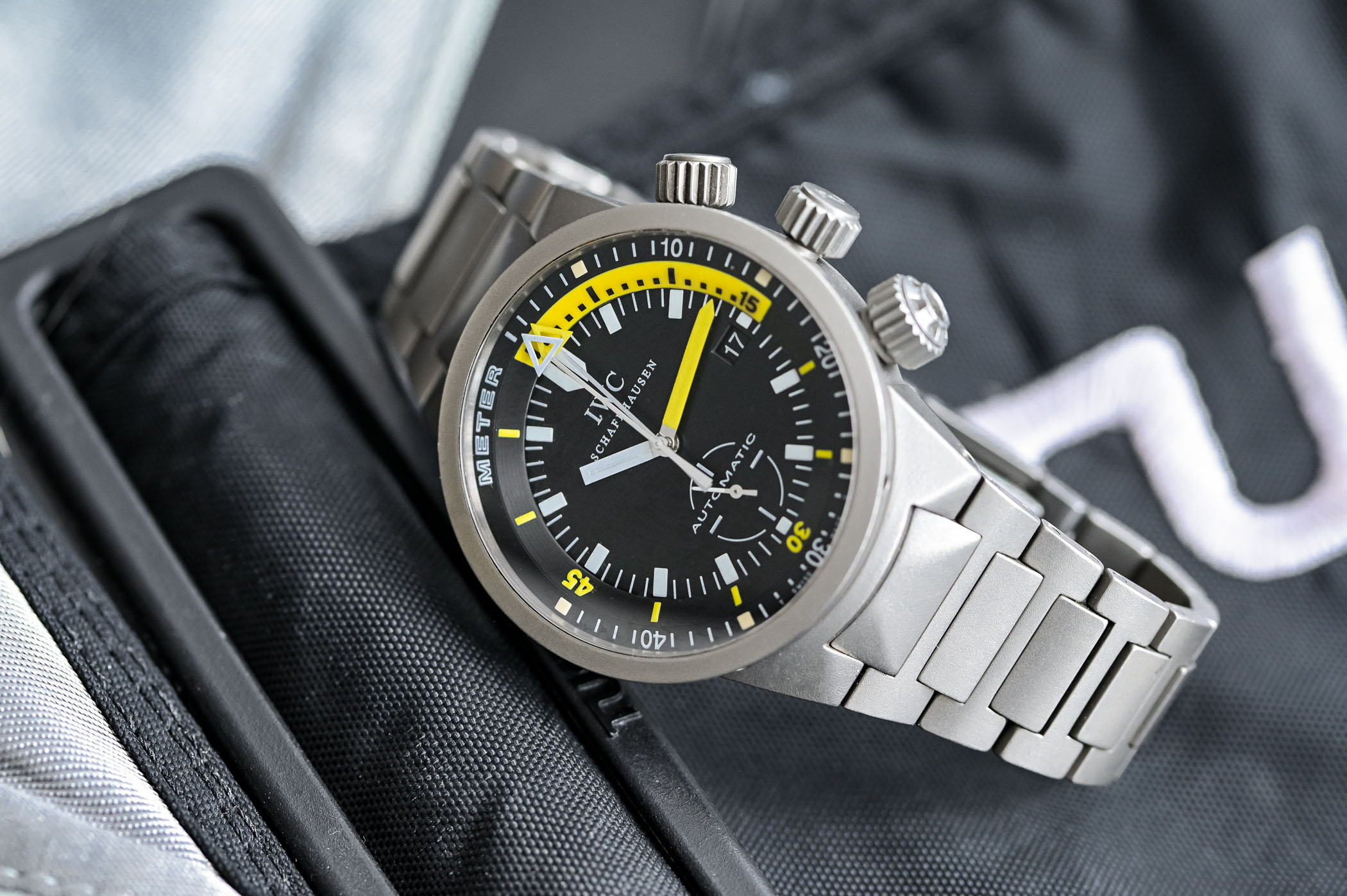Since its founding in 1868, IWC has built a reputation for producing instruments where precision engineering meets uncompromising functionality. This approach, a combination of Swiss watchmaking tradition with an emphasis on mechanical problem-solving, has consistently produced watches designed to serve a clear purpose. This philosophy is very much evident in IWC’s dive watches, also known as the Aquatimer. Today, in our latest instalment of The Evergreens, we’ll be looking at the complete history of this collection as well as other important dive-oriented watches from Schaffhausen.
The story begins in 1967 with the launch of the first Aquatimer, created during an era when recreational and professional diving were rapidly expanding, and the demand for robust, water-resistant timepieces was at its peak. IWC’s early dive watches came late compared to other brands (Rolex, Blancpain or Zodiac) but reflected the lessons of the tool-watch age: overbuilt cases, legible dials, and bezels engineered to track bottom time with absolute clarity. But from the start, the company also looked for ways to push beyond the standard formula, experimenting with case designs, technology, and safety systems that would distinguish their divers from those of other manufacturers.
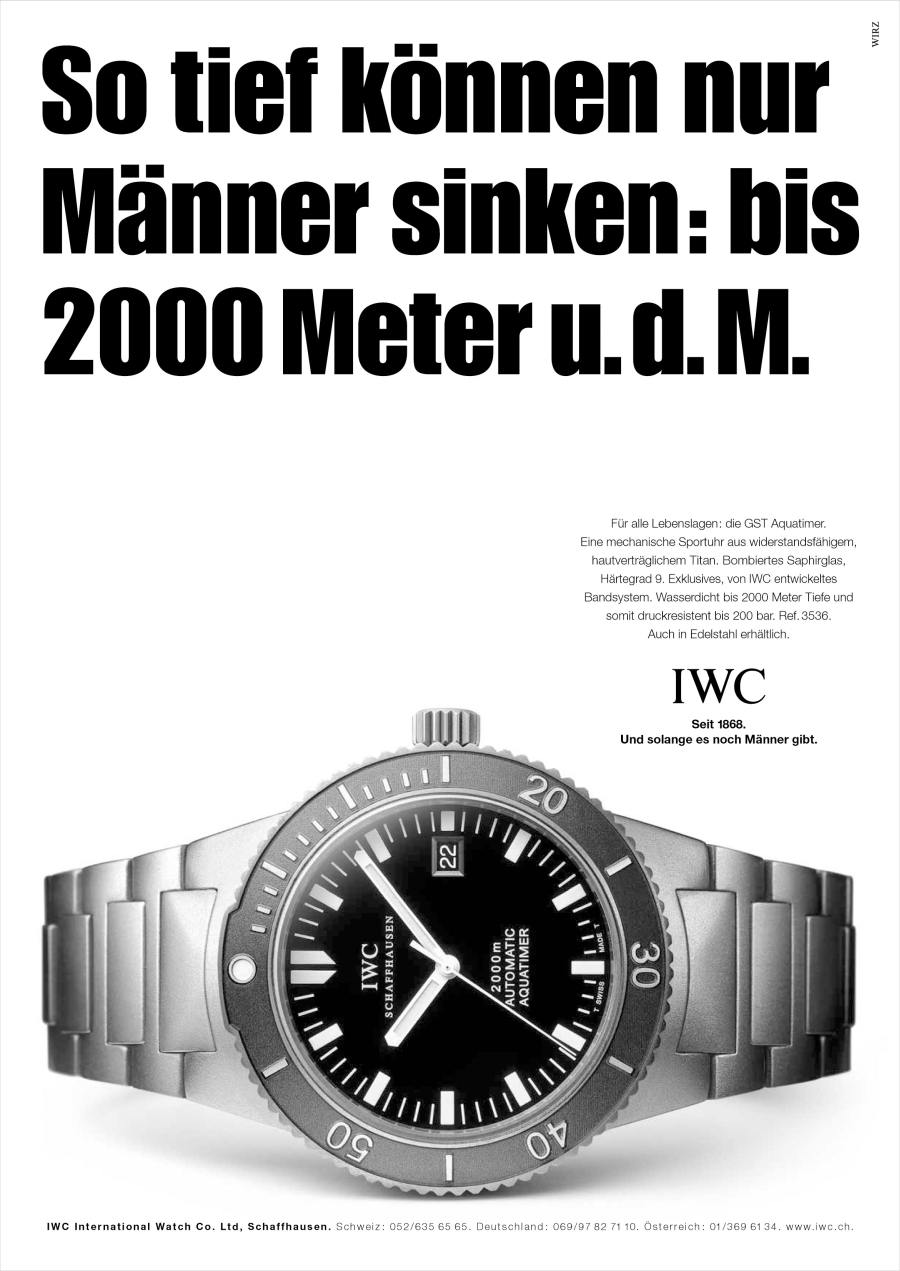
Over the decades, IWC’s dive watch lineage has been defined not by a single style but by a series of technical milestones. From the Super Compressor-cased originals to the titanium-cased Porsche Design Ocean 2000 of 1982, the first production dive watch rated to 2000m, to the 1990s GST Aquatimer series with extreme-depth capabilities and the GST Deep One which pioneered the mechanical depth gauge, leading to even more advanced dual-indicator systems in the Deep Two and Deep Three, IWC’s engineering approach has been consistent: start with the real-world needs of the diver, whether military, commercial, or recreational, then build a watch that meets those needs. Aesthetic considerations followed the functional, resulting in watches whose visual identity is inseparable from their technical purpose.
The chapters that follow trace more than half a century of continuous innovation in underwater horology, revealing how IWC’s dive watches have responded to and shaped the changing demands of underwater exploration.
The Early Years of the IWC Aquatimer
Aquatimer Ref. 812 (1967)
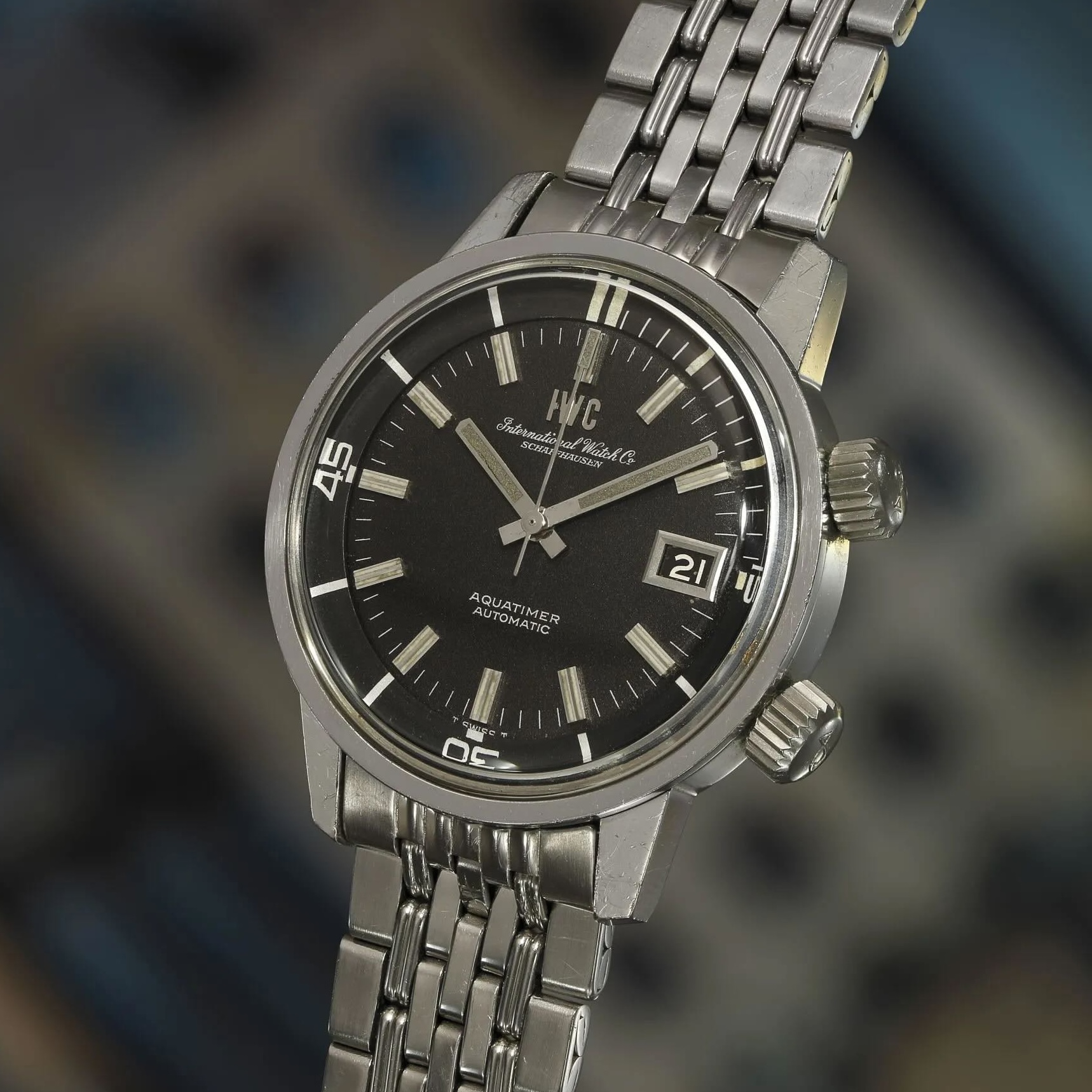

In 1967, IWC unveiled the Aquatimer Ref. 812 (later designated as 812 AD and Ref. 1812 after IWC’s reference system update in 1972). This marked the Schaffhausen manufacturer’s entry into the professional dive watch market for the first time. By then, Blancpain, Rolex, Omega and Seiko had already defined much of the segment. Yet, IWC’s late arrival brought a distinct engineering philosophy and a design that remains a collector favourite, and for a reason.
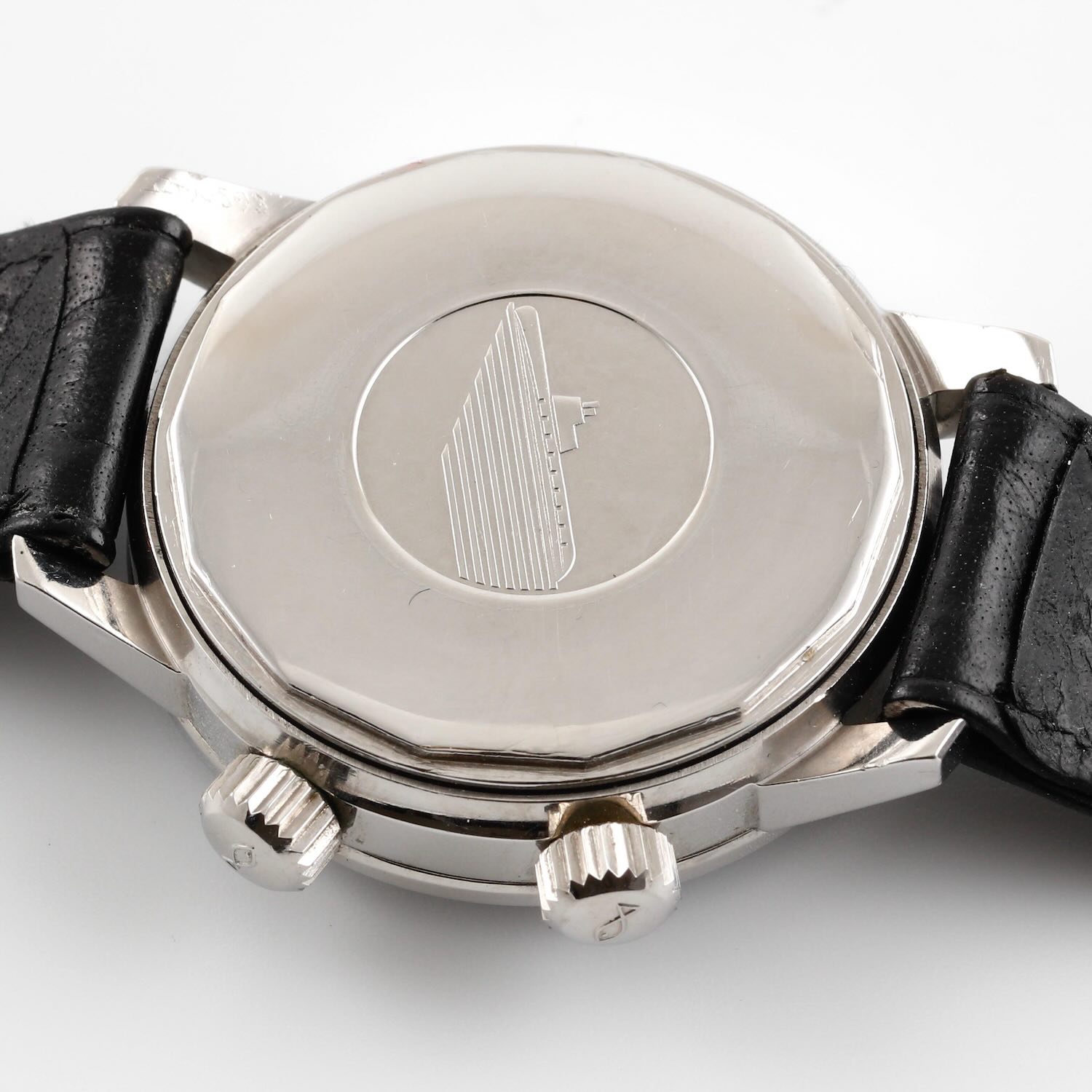

The Ref. 812 was built with the EPSA Super-Compressor case, a patented system by Ervin Piquerez S.A. in which increased water pressure strengthened the case’s seal the deeper it went. Measuring 37mm in diameter, with a modest profile and sharply defined lugs, it offered 200m of water resistance. Its most recognisable feature, the twin screw-down crowns with the newly developed spring system seals, at 2 and 4 o’clock, served two separate functions: the lower one rotated the internal dive bezel, protected under the crystal, while the other handled winding, setting, and date adjustment. This protected bezel system reduced the risk of accidental knocks during a dive and gave the watch its clean, functional look.
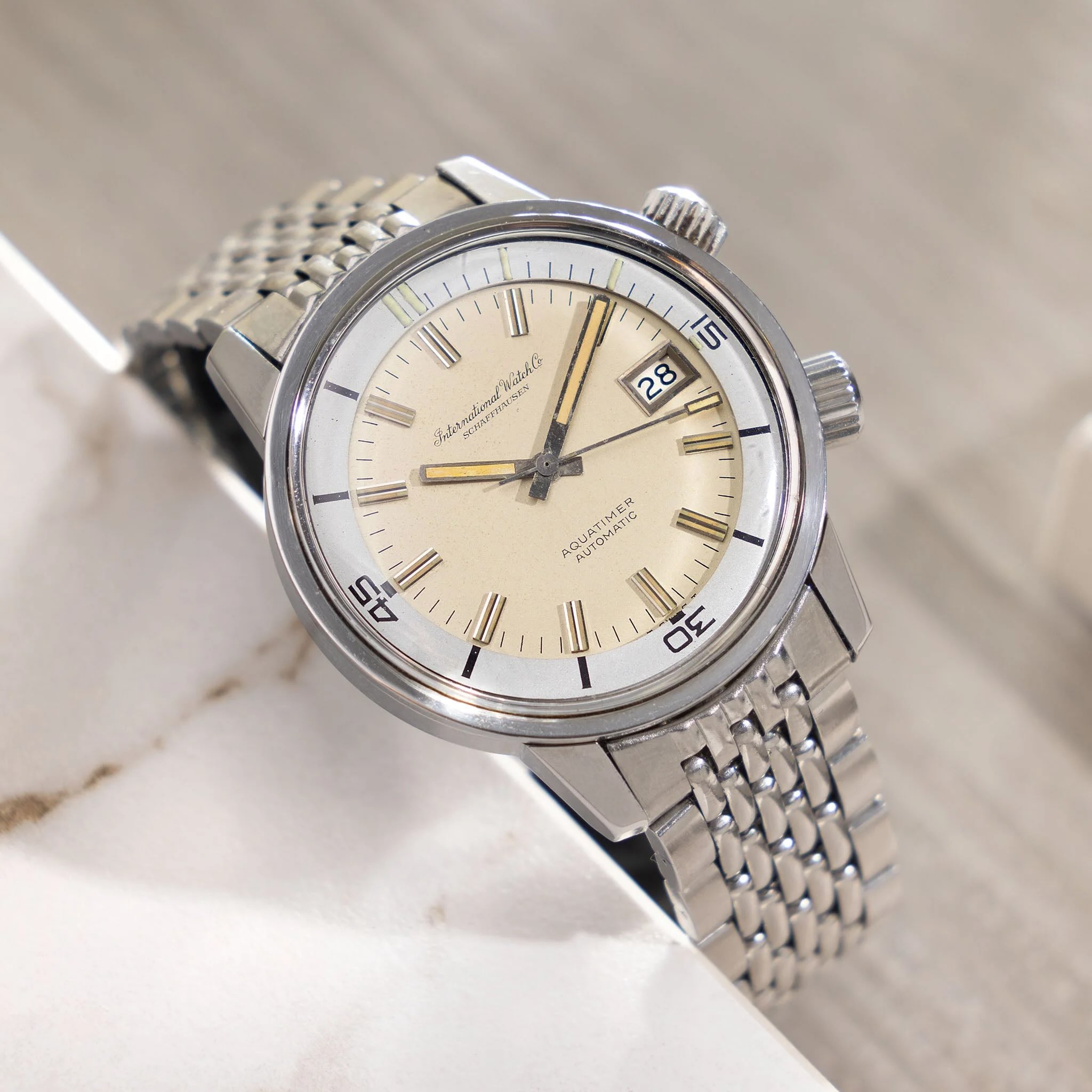

Across its production life from 1967 to 1982, four dial variants were offered: black dial with black bezel, black dial with silver bezel, white dial with black bezel, and the rare white dial with silver bezel. Applied, expressive hour markers and baton-style hands were treated with luminous material, and a paddle seconds hand with a lume-filled tip provided clear underwater legibility. The framed date window at 3 o’clock added functionality without damaging the overall dial design. The “IWC” applied logo below 12 appears on some examples but not others, a reflection of branding changes during the late 1960s.
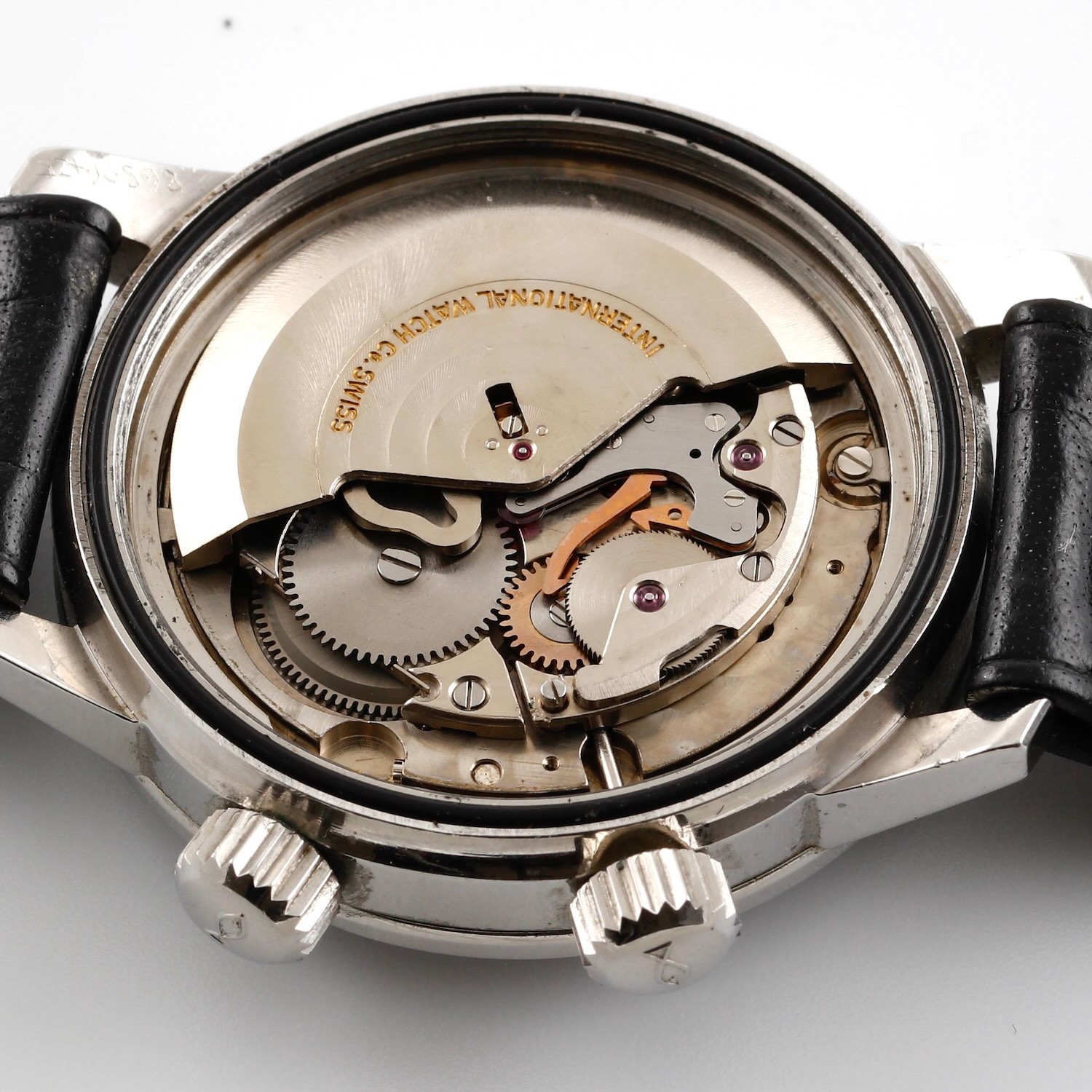

Power came from the in-house Calibre 8541, a robust self-winding movement with IWC’s Pellaton winding system, operating at 19,800 vibrations/hour, with a 40-hour power reserve. Around 1970, the upgraded 8541B added hacking seconds and a Grenier-type hairspring collet. This movement also powered contemporary Ingenieur models, underscoring IWC’s modular and efficient approach to movement manufacturing.
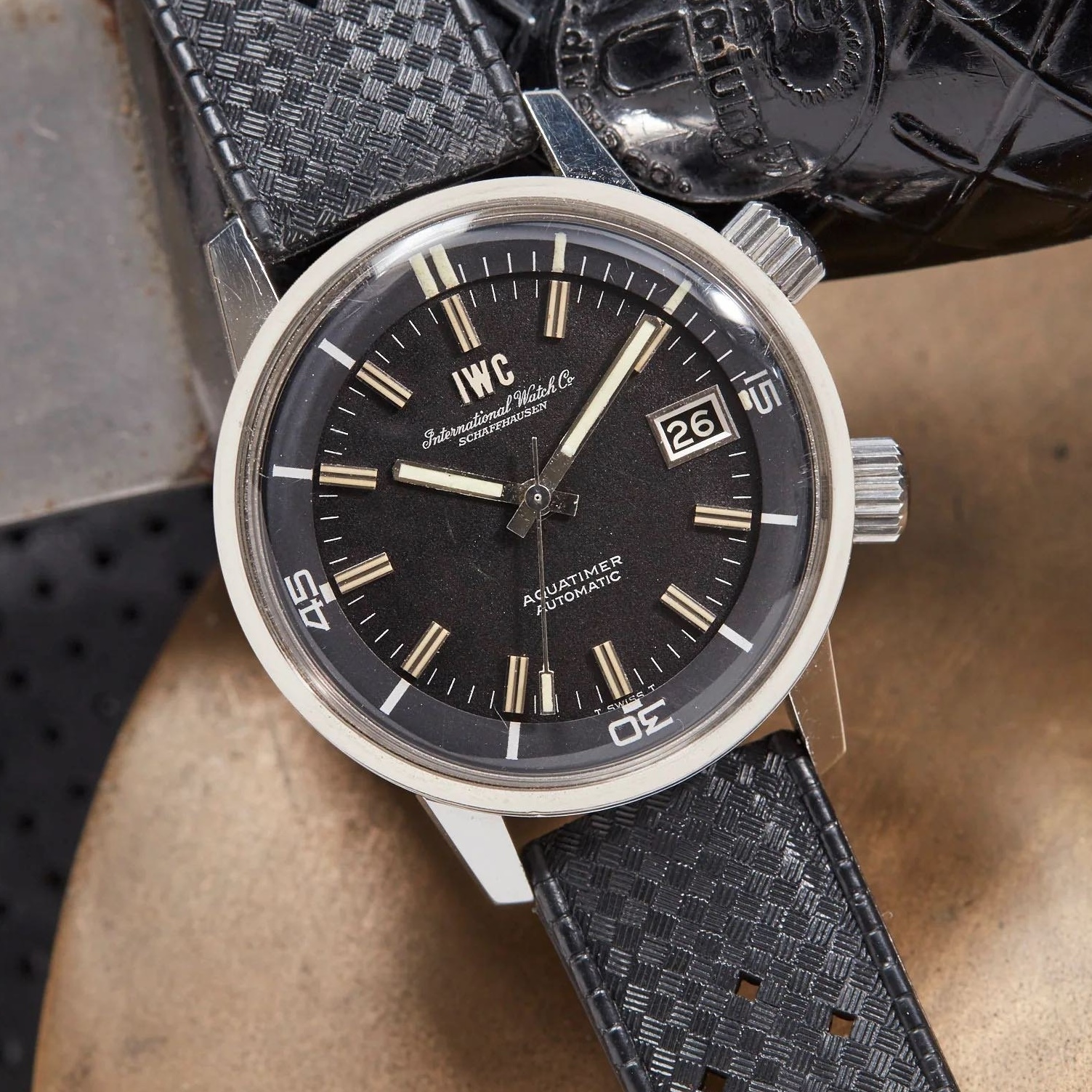

Notably, the Ref. 812 balanced engineering practicality with understated style. The Super-Compressor system offered a reliable and innovative alternative to external ratcheting bezels. At the same time, the restrained case size and dial layouts made it suitable for everyday wear, a rarity among serious tool watches of the era.
Aquatimer Ref. 816 (1968)
Just a year after IWC introduced its first-ever dive watch, in 1968, the company unveiled the Ref. 816AD, later re-designated Ref. 1816, brought stronger performance, bolder looks, and subtle technical upgrades that set it apart from its predecessor.
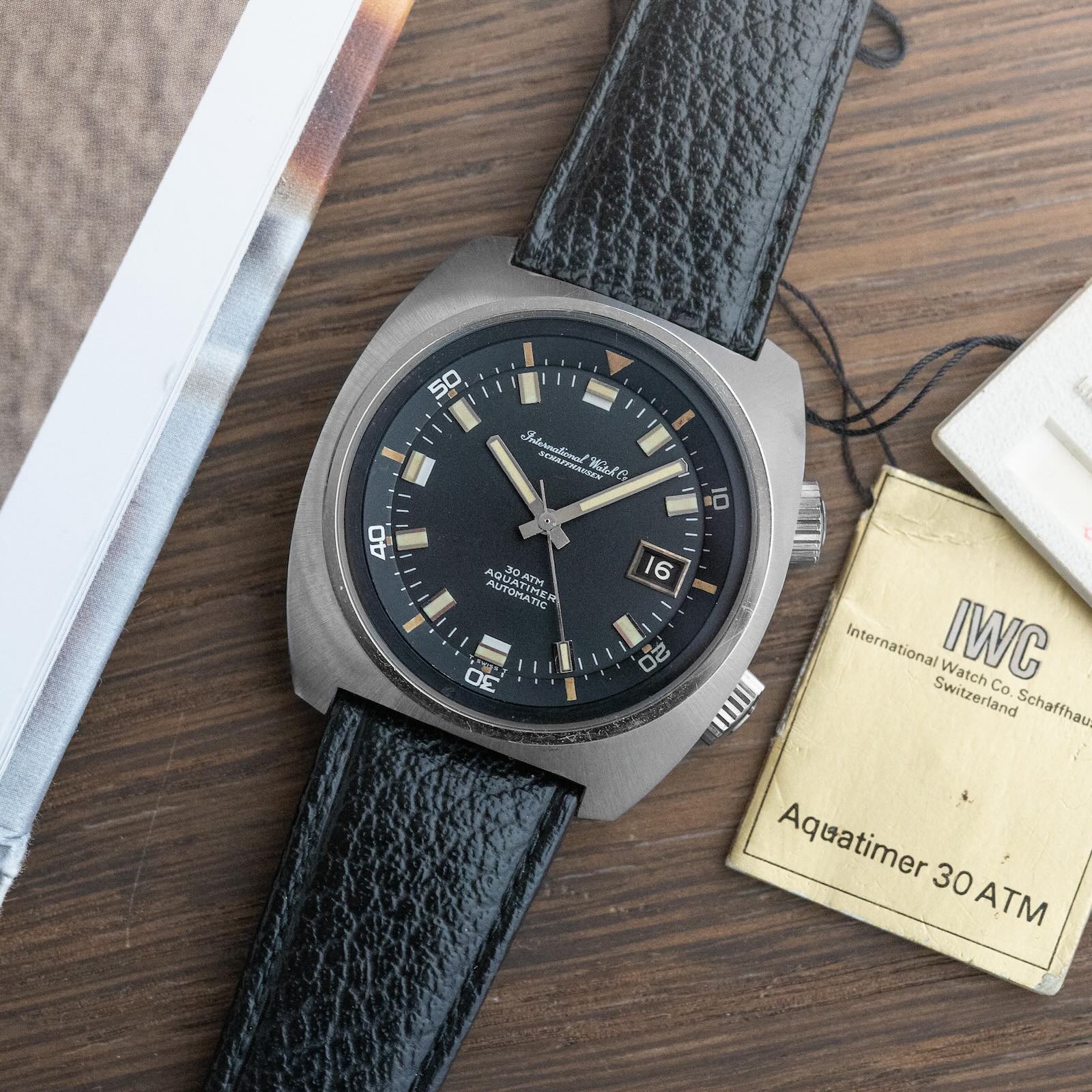

The most notable change was its case. Still an EPSA-manufactured Super Compressor, it now adopted a cushion-shaped profile that gave the watch a more contemporary presence on the wrist. Water resistance was boosted to 300m, placing the 816 firmly in professional territory. The hallmark dual-crown layout remained, and both featured the familiar IWC fish emblem.
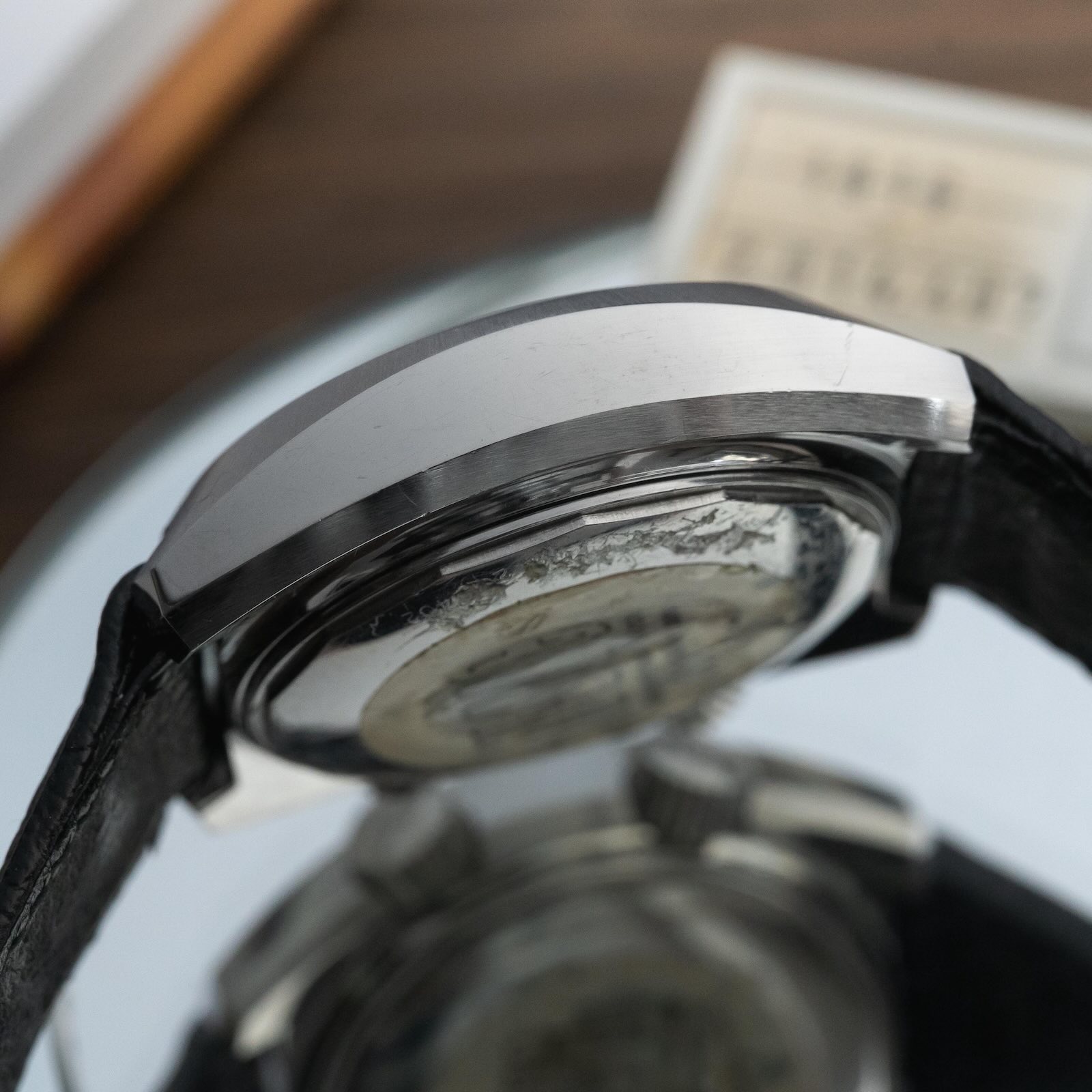

The dial, however, was where the 816AD became instantly recognisable. Available in black, red shadow, or blue shadow configurations, each offered a strong visual contrast against the inner bezel with double-digit numerals at 10-minute intervals. The handset remained the same, the date window at 3 o’clock stayed, yet the applied markers were redesigned.
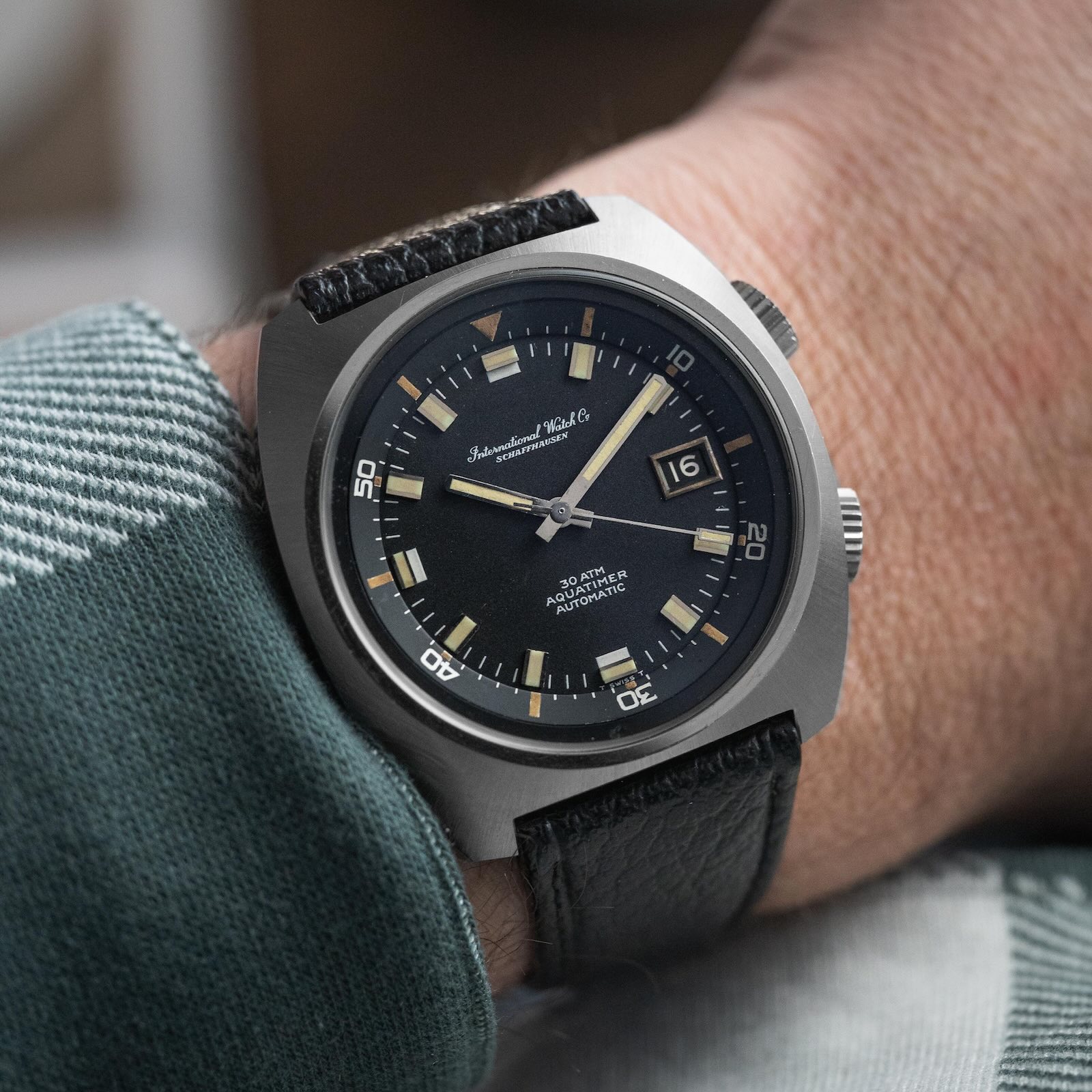

The watch relied on the same Calibre 8541 automatic movement with IWC’s Pellaton winding system as the inaugural model, well suited to the Aquatimer’s tool-watch role. Production of the 816AD/1816 spanned over a decade before being succeeded by the Ref. 1822, which introduced updated dial and bezel designs. While exact numbers are elusive, total output across early Aquatimer generations was modest, in the low thousands for all 812 and 816 variants combined.
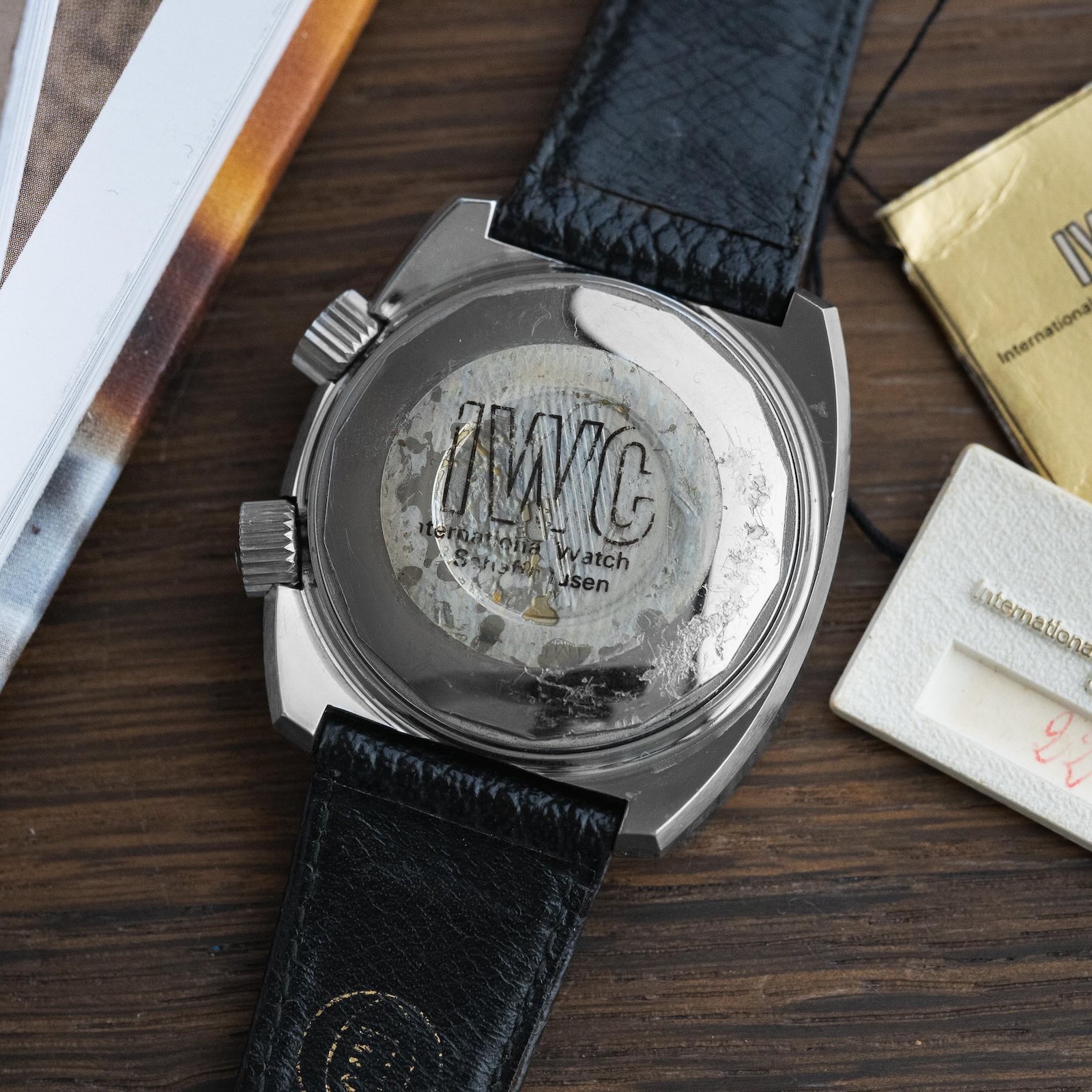

In the context of the Aquatimer’s evolution, the Ref. 816AD bridged the gap between the clean, almost conservative lines of the 812AD and the more angular, modern designs that would follow. With greater depth rating, bolder dial options, and the same no-nonsense engineering ethos, it confirmed IWC’s credentials in the dive watch market.
Conquering the New Depths with the 2000 series
IWC Porsche Design Ocean 2000 – Ref. 3500/3504/3524 and the Bund models
By the early 1980s, the Aquatimer line had to evolve beyond its Super Compressor roots, and IWC was searching for ways to push professional dive watch design far beyond conventional limits. That search coincided perfectly with its partnership with Porsche Design, founded in 1972 by Ferdinand Alexander “Butzi” Porsche after he departed from the family’s car business. The relationship resulted in experimental pieces like the IWC Compass Watch and Titan Chronograph, where titanium and anti-magnetic engineering were first explored. It reached its important point in 1982 with the launch of the Porsche Design Ocean 2000.
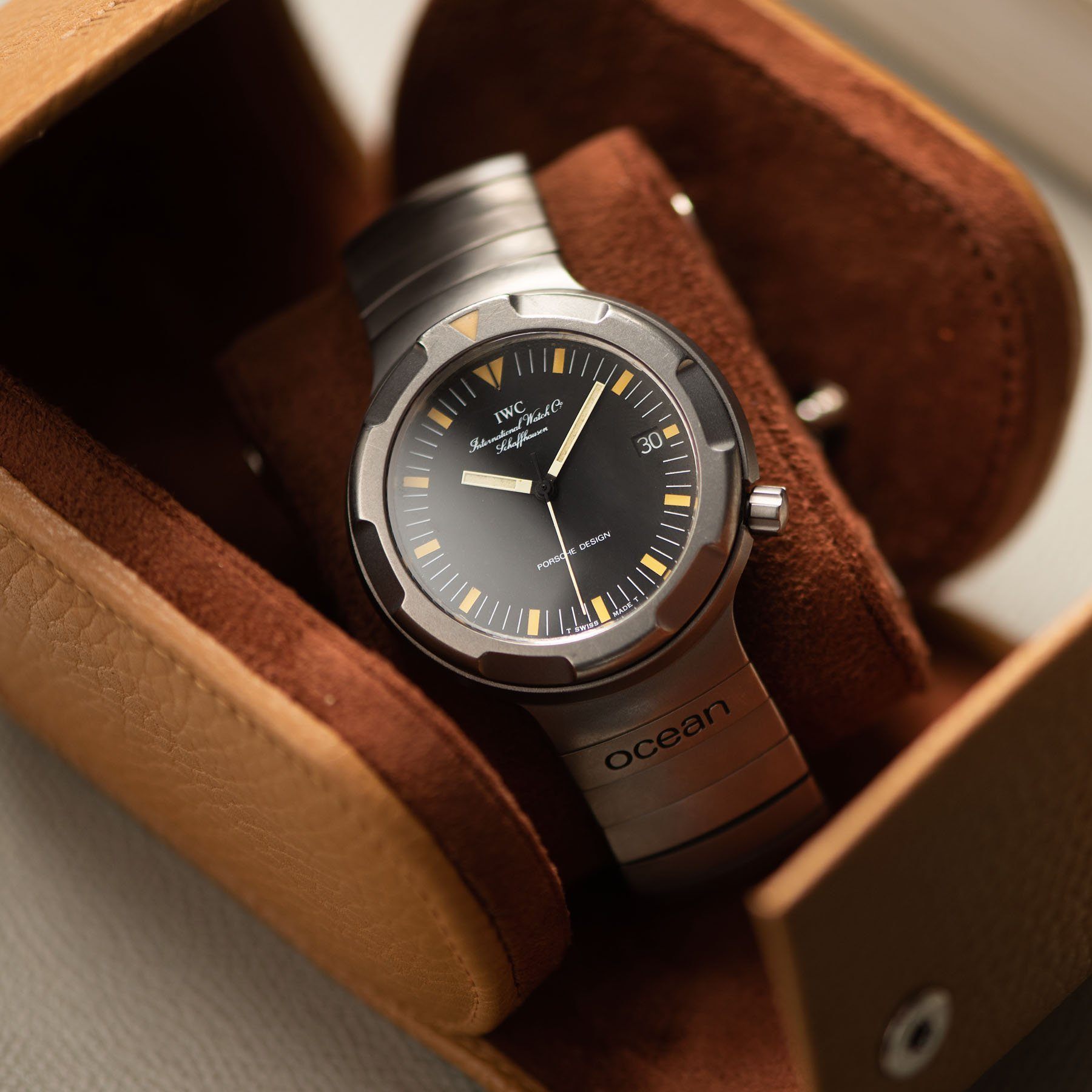

The Ocean 2000 was the first production dive watch to be made entirely from titanium, a material IWC had been quietly mastering since the late 1970s. Machining titanium was notoriously difficult at the time, requiring special tooling and expertise. The payoff was a case that was lighter than steel, immune to seawater corrosion, and hypoallergenic. Designed by Butzi Porsche, the 42 mm monobloc case was stripped of ornamentation, its integrated bracelet flowing seamlessly from the body, mirroring the case’s sleek geometry and closed with a double-folding safety clasp.
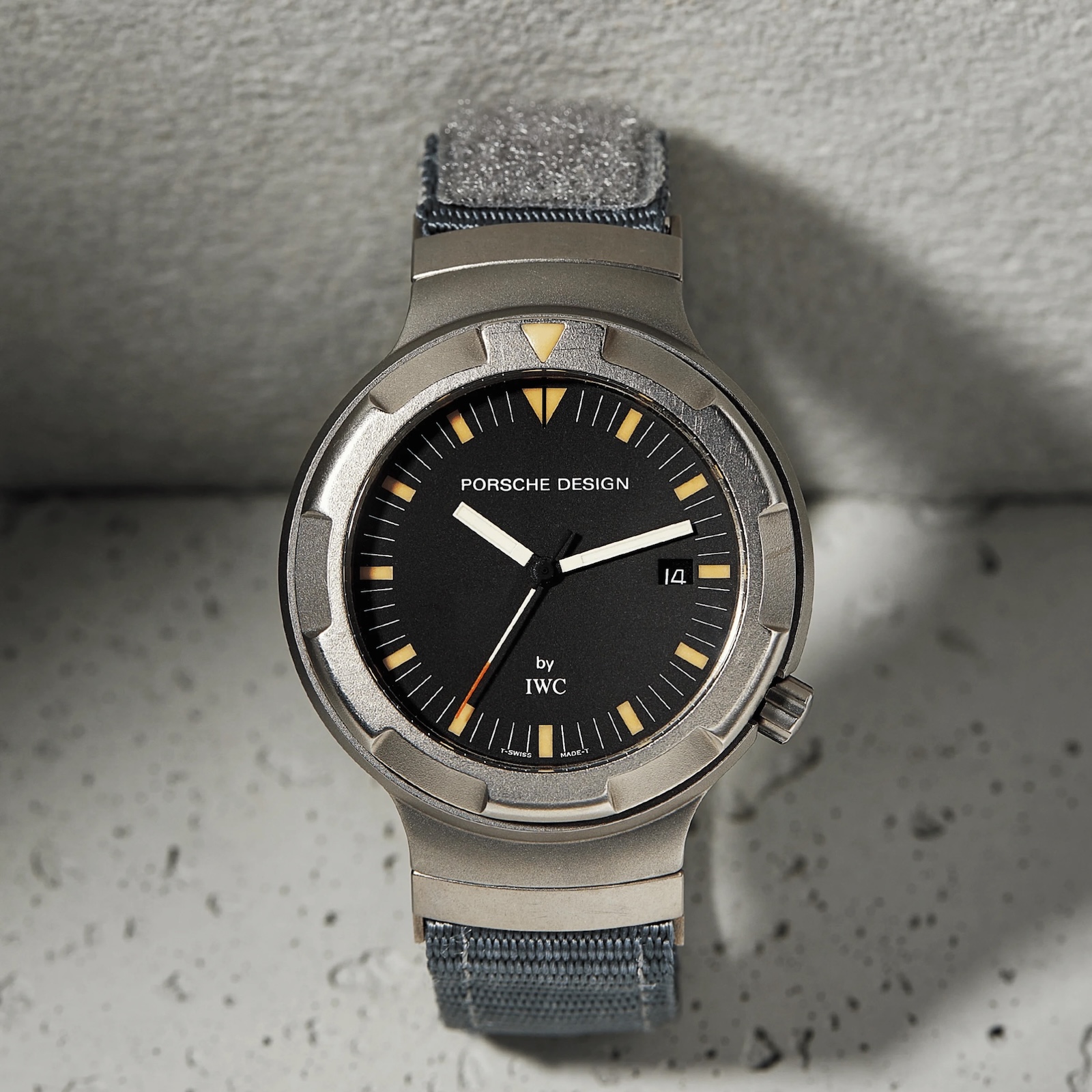

Concealed beneath the rather minimalist form was formidable engineering: water resistance to 2000m, achieved through a unique crystal-to-case sealing system, a 3.7mm sapphire crystal, and a screw-down crown with triple pressure-limiting devices. The recessed unidirectional bezel sat flush with the case to minimise snag hazards, with precisely engineered detents for security. The civilian Ocean 2000 was powered by the IWC Calibre 375, based on the ETA 2892, chosen for its slim profile and reliable performance.
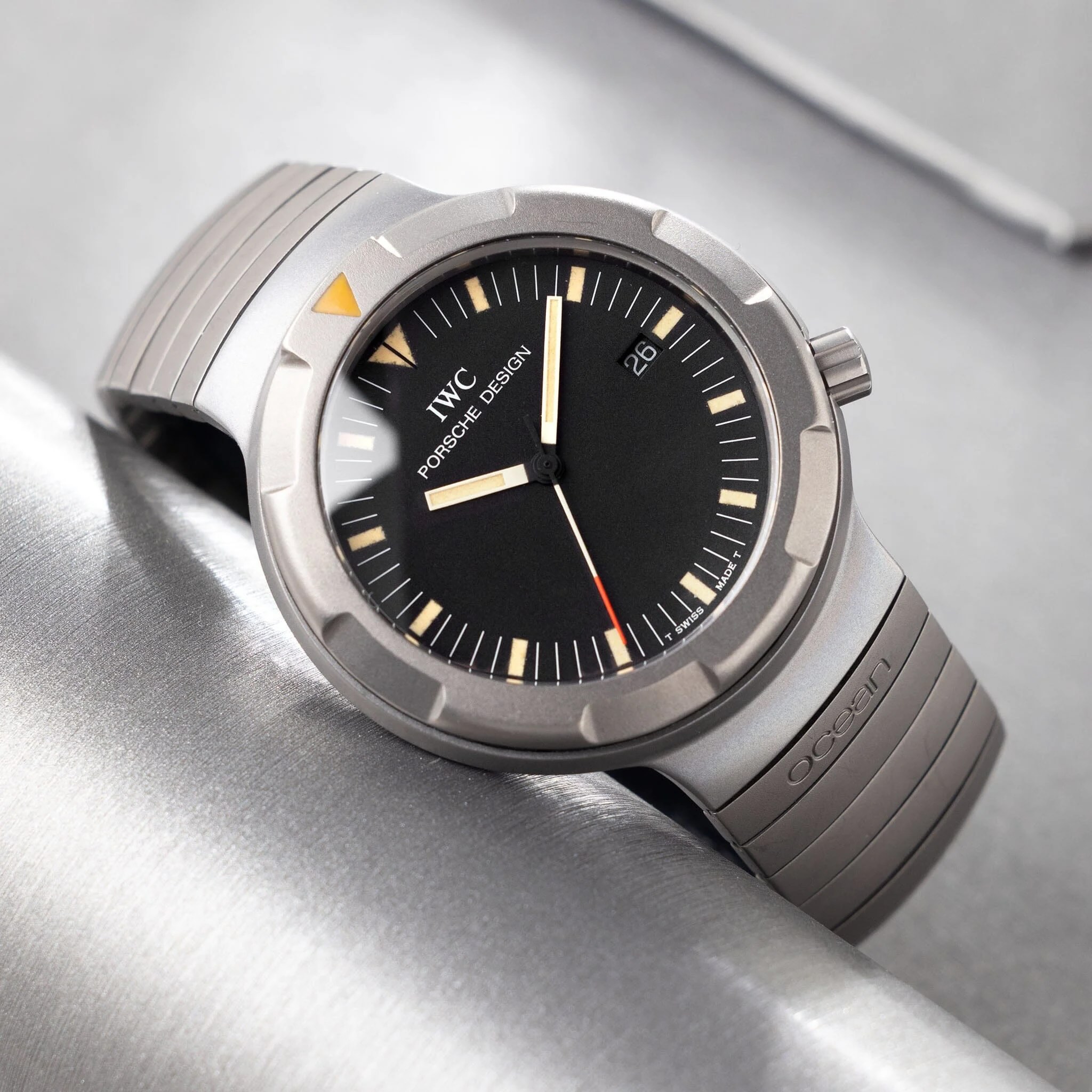

But the Ocean 2000’s engineering would soon serve a far more specialised purpose. In the early 1980s, the German Navy issued a 30-page technical specification for a new professional diver’s watch for its elite mine clearance divers, the Minentaucher. The task was unusually complex: the watch had to be entirely non-magnetic to avoid triggering Soviet-designed magnetic fuses in anti-shipping mines. IWC’s titanium expertise made it the natural choice for the project, and the result was the Bund Ocean 2000.


Image by Phillips Watches
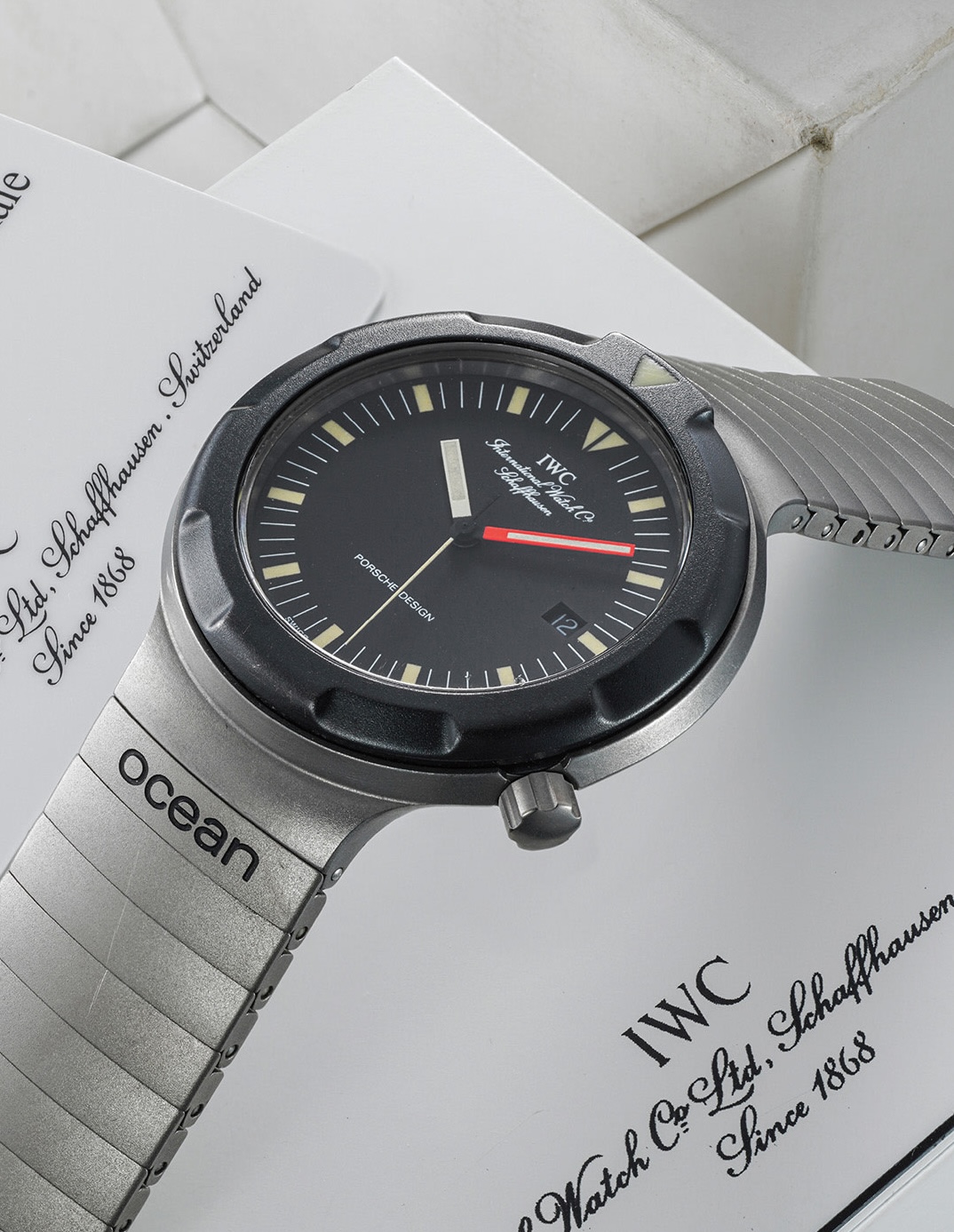

Image by Phillips Watches
According to Phillips, it was “born out of the cooperation between Swiss watch manufacturer IWC and a branch of the legendary sports car manufacture Porsche, the Bund Ocean 2000 holds a place of special importance within the history of the company as it is the last line of watches made specifically for military purposes. A military re-edition of the Porsche Design Ocean 2000 line, which were originally launched in the early 1980s, the Bund project was made alive thanks to the contract obtained by IWC with the West German Army to deliver mil spec versions of their current watches. Different from their “civilian” counterparts, the mil-spec timepieces, like the present example, most notably featured an orange minute hand, a black bezel, a flat crystal and a nylon strap (the titanium bracelet was optional). Interestingly, while the civilian version was rated to 2000 meters below sea level (thus its name “Ocean 2000″), the military version was only tested up to 300 meters.” The auction house adds that “three different models were made for the Navy: a “Kampftaucheruhr” (combat diver) model, bearing reference 3314 or 3315 introduced in 1983; a “Minentaucheruhr” (minesweeper models) reference 3519, and the “Taucheruhr” (diver) model reference 3529, or 3509.”
IWC GST Aquatimer 2000 – Ref. 3536 (1998)
By the late 1990s, IWC had mastered production of watches for extreme underwater use, and in 1998 it unveiled the GST Aquatimer 2000 Ref. 3536, a watch that distilled the technical rigour of the 3519 into a model designed for civilian deep-sea exploration. Part of the GST line, so named for its use of gold, steel, and titanium, the 3536 was a pure expression of late-1990s IWC design: functional, modern, and stripped of excess.
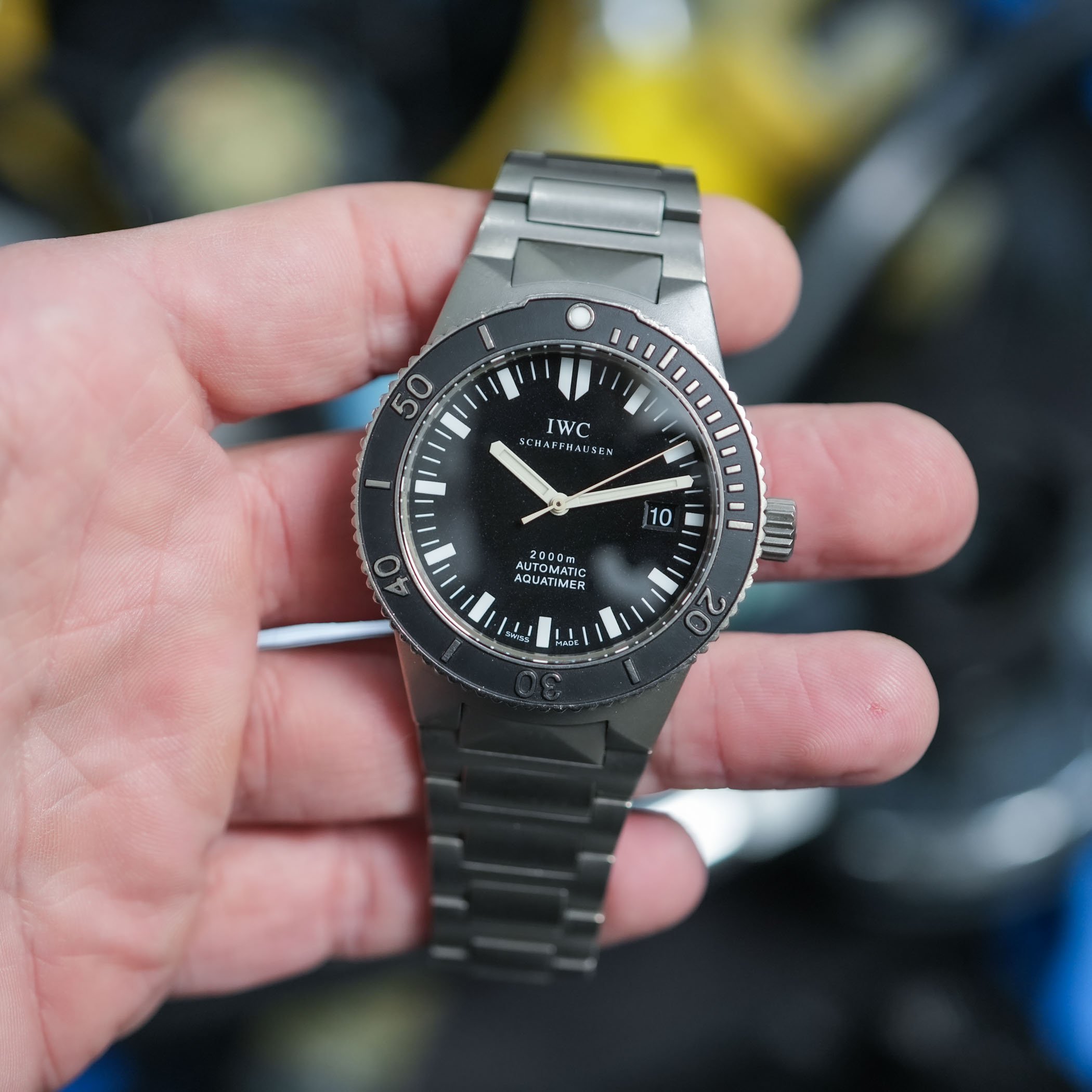

The 42mm case, around 14mm thick, was available in either stainless steel or titanium. The 3536 boasted extraordinary water resistance of 2000 m, which a few mechanical divers could match even decades later. This performance was the result of a reinforced case architecture with a thick screw-down case back, a screw-in crown with multiple gaskets, and integrated crown guards to shield against impact damage. The unidirectional bezel featured a precise ratcheting mechanism with sharp, tactile clicks, eliminating the risk of accidental over-rotation.
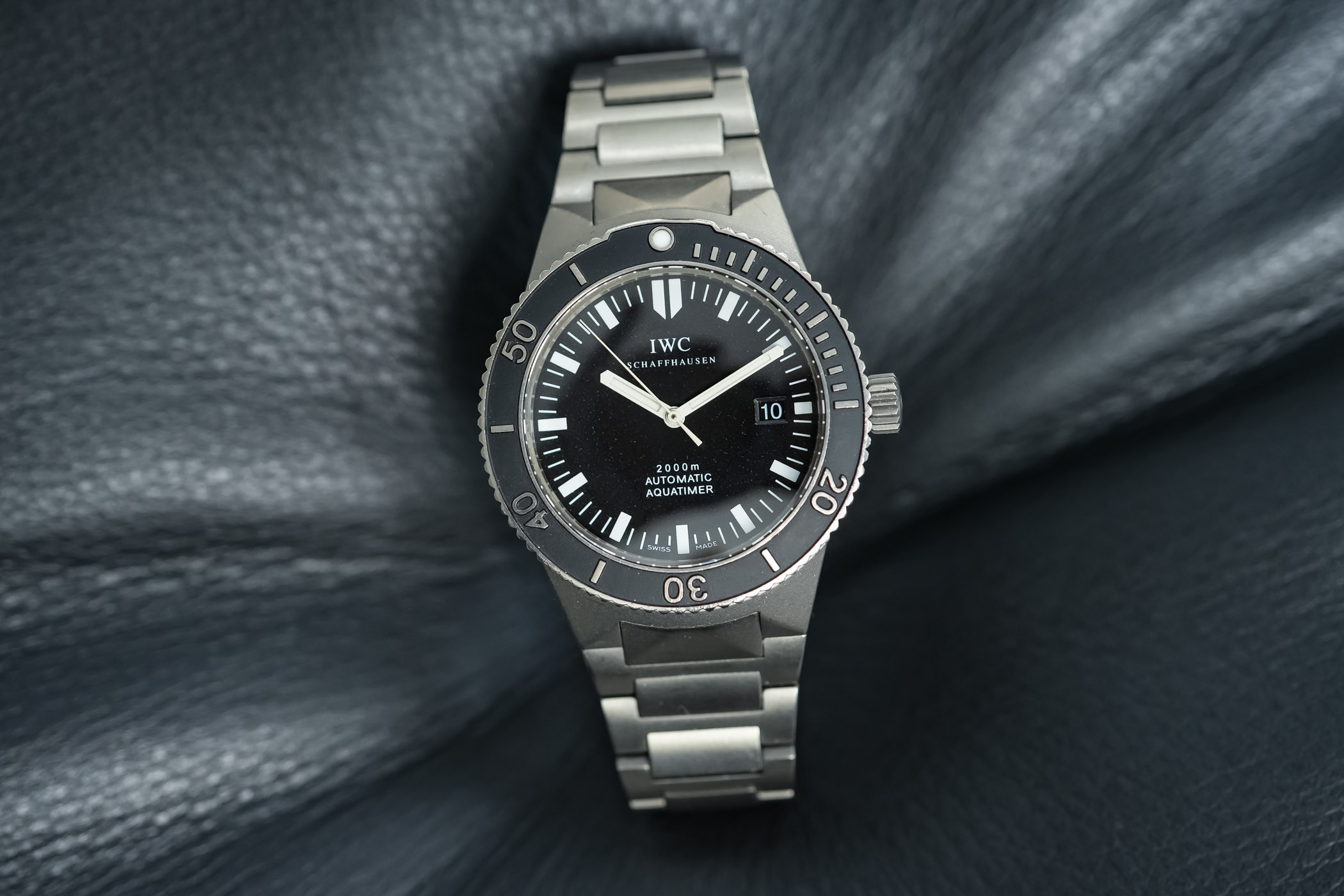

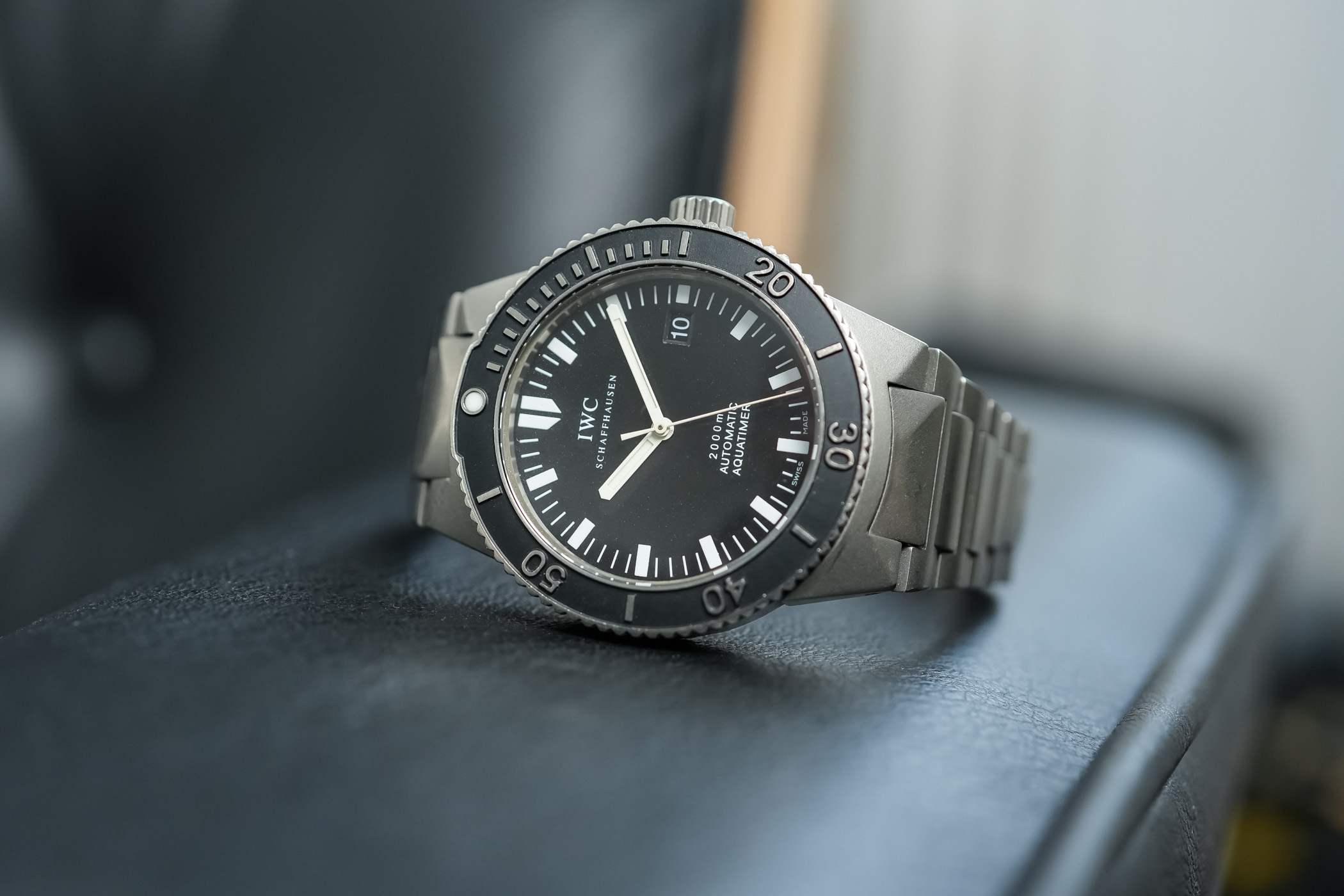

The dial was engineered for instantaneous legibility in the low-light conditions of the deep. Large luminous hour markers and broad Super-LumiNova-filled hands stood out against a matte black background, and a discreet date display at 3 o’clock did not clutter the dial. The IWC Calibre 37524, based on the ETA 2892-A2, delivered reliable timekeeping operating at 28,800 vibrations/hour and a 42-hour power reserve.
The GST Aquatimer 2000 Ref. 3536 offered a combination of extreme depth rating, meticulous engineering, and understated design, which made it one of the most uncompromising Aquatimers ever built, and a benchmark against which serious dive watches are still measured.
Measuring Depths – The Trilogy Initiated by the Deep One
IWC GST Deep One Ref. 3527 (1999)
The GST Deep One Ref. 3527, launched in 1999 as part of IWC’s GST collection, was one of the most technically ambitious watches of its era. It came with an integrated mechanical depth gauge, a complication that remains exceptionally rare even today, and was a landmark in professional dive watch design. Arriving just two years after the end of IWC’s two-decade collaboration with Porsche Design, the Deep One reflected the brand’s determination to create a new generation of in-house engineered tool watches.
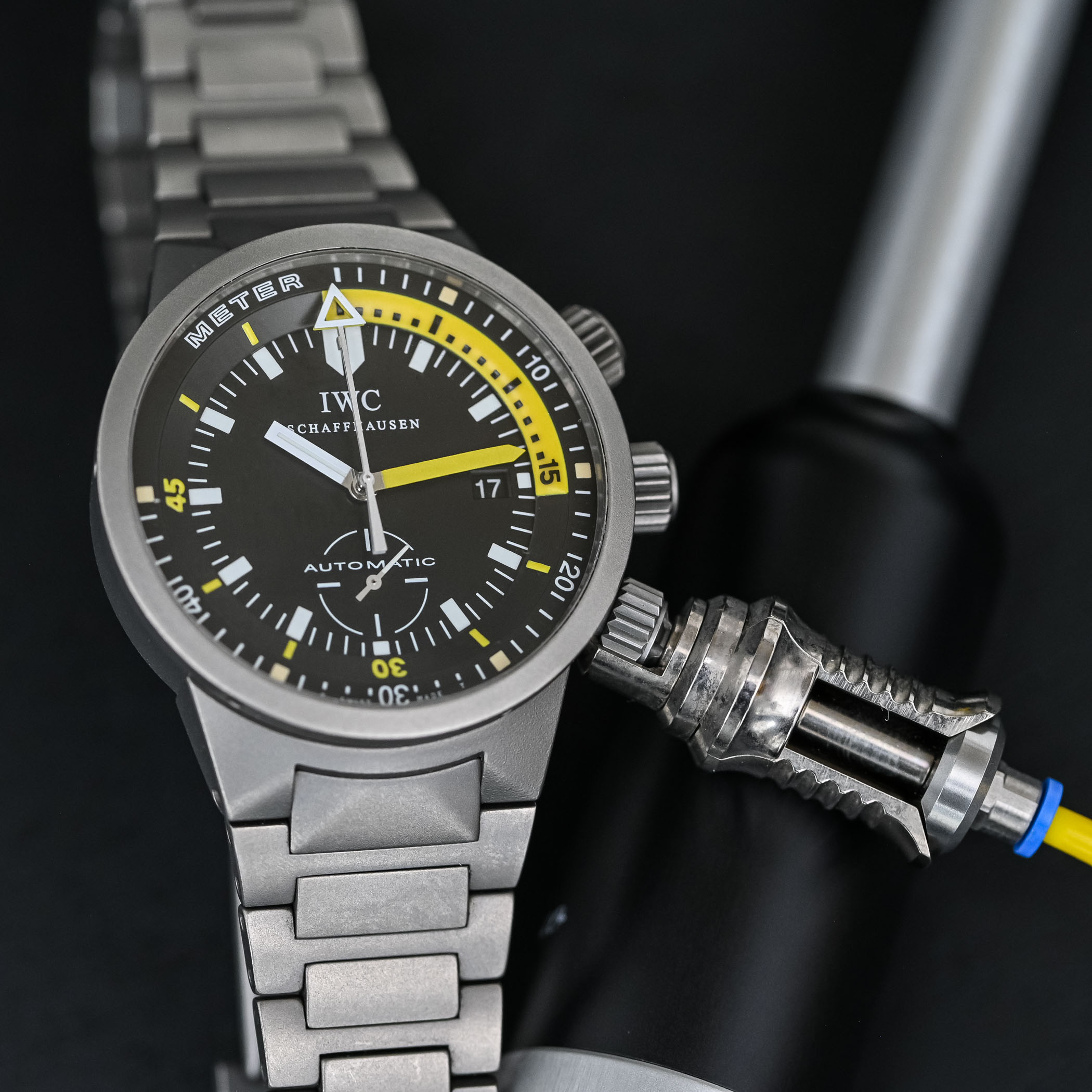

The Deep One used the IWC Calibre 8914, an extensively modified version of the ETA 2892-A2, adapted to host the depth gauge mechanism on the dial side without adding much thickness to the watch.
The depth gauge itself was a feat of mechanical ingenuity. Using a miniature Bourdon tube pressure sensor embedded within the titanium case, it translated water pressure into precise mechanical readings. As the diver descended, the curved metal tube deformed slightly, and this movement was transferred through a finely engineered system of levers and gears to two central skeletonised arrow hands. One hand displayed the current depth in real time, while the other recorded the maximum depth reached, remaining fixed until manually reset via a crown at 4 o’clock. The depth scale, printed on the dial’s outer perimeter and marked “METER,” was calibrated to 45 metres, with finer graduations in the critical shallow-water range for decompression-stop accuracy. Because it was entirely mechanical, the system required no batteries or electronics, offering divers a dependable backup to their electronic dive computers.
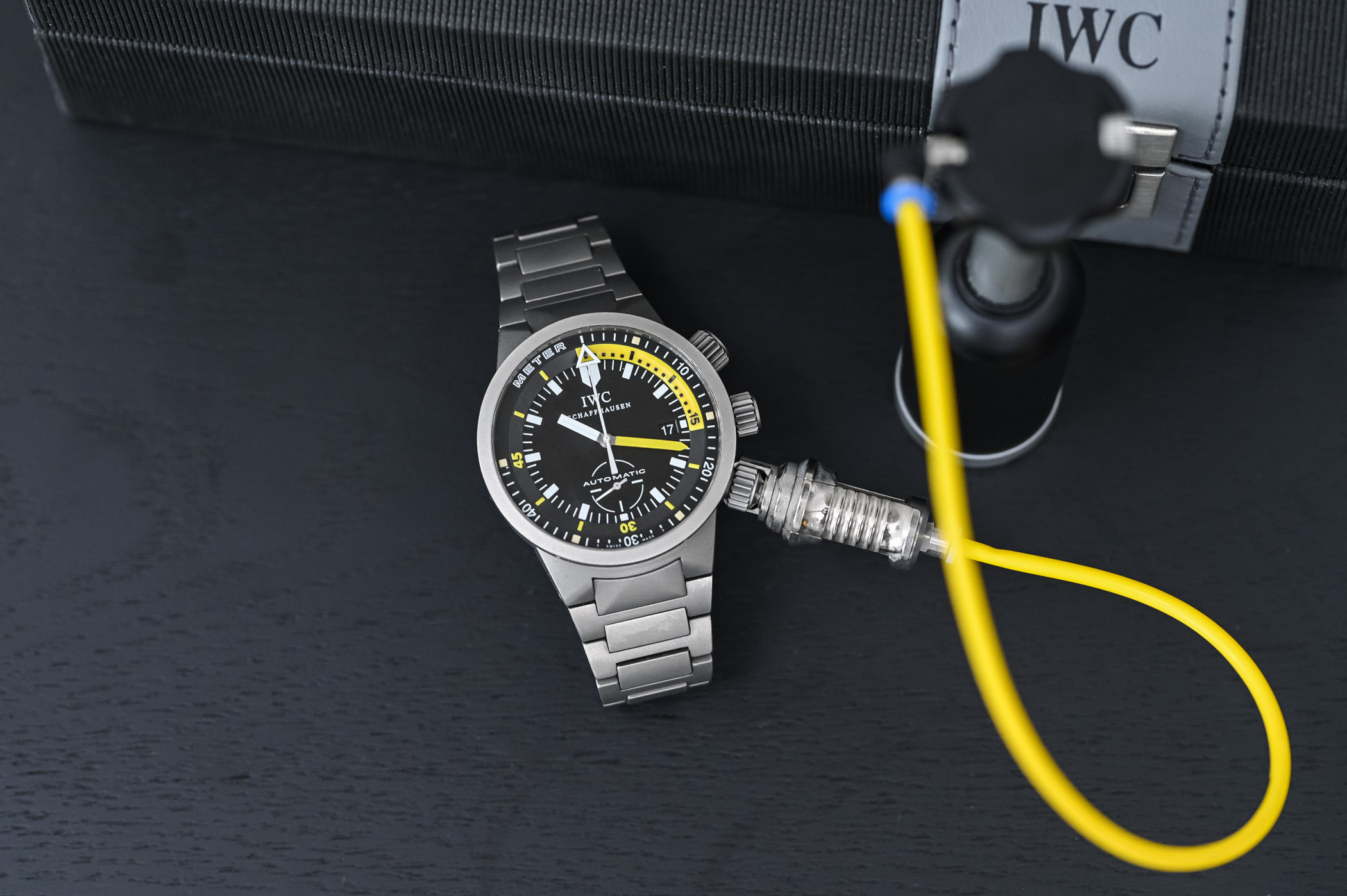

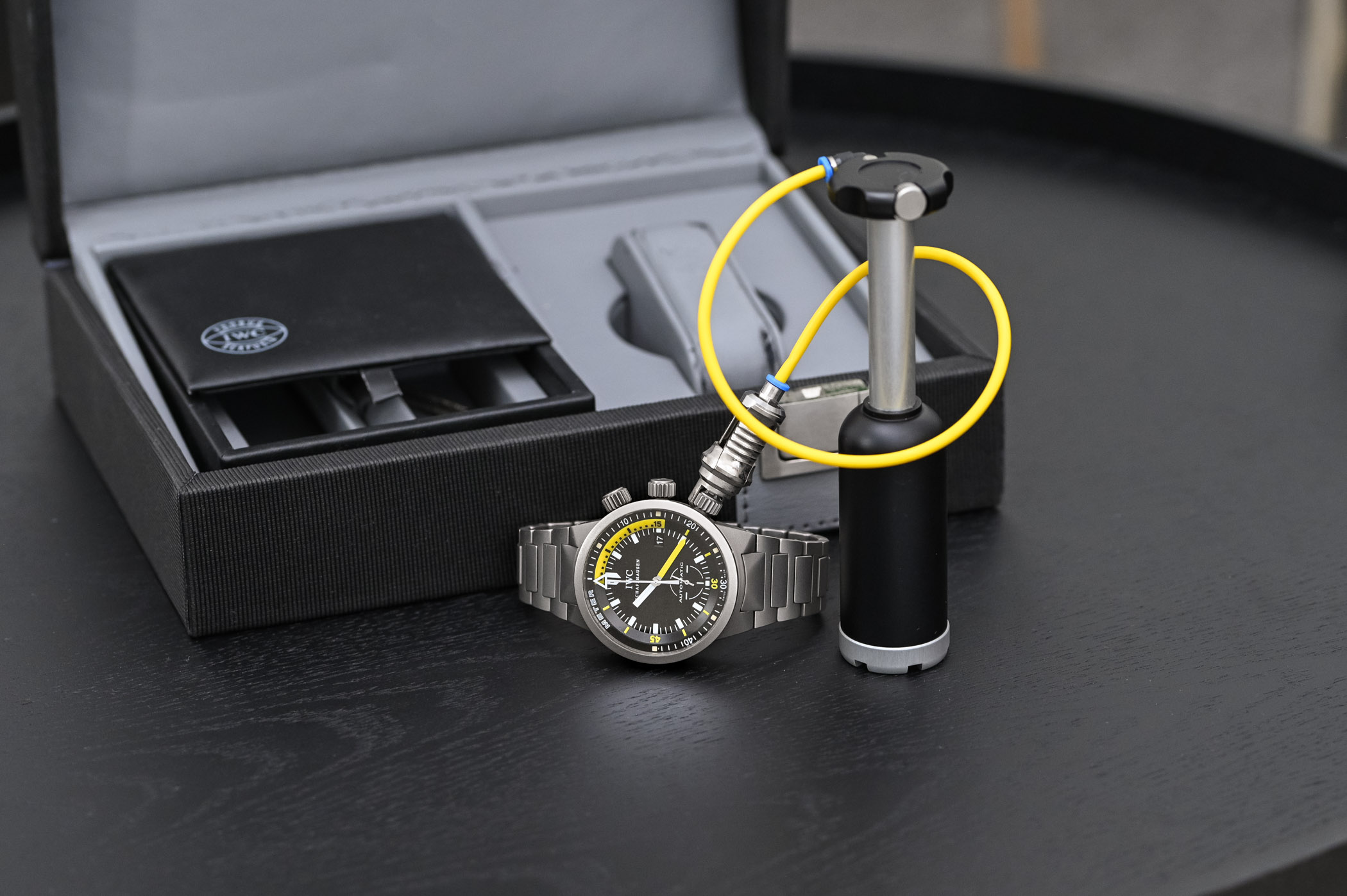

The case measured 42.8 mm in diameter, 14.75 mm in height, and 49.1 mm from lug to lug. Crafted from bead-blasted titanium, it combined lightness, strength, and resistance to corrosion in saltwater, while also being hypoallergenic. Water-resistant to 100 m, it featured a screw-down crown for time setting, a screw-in case back, and an internal unidirectional rotating bezel operated by a dedicated crown, chosen to prevent accidental adjustments during a dive.
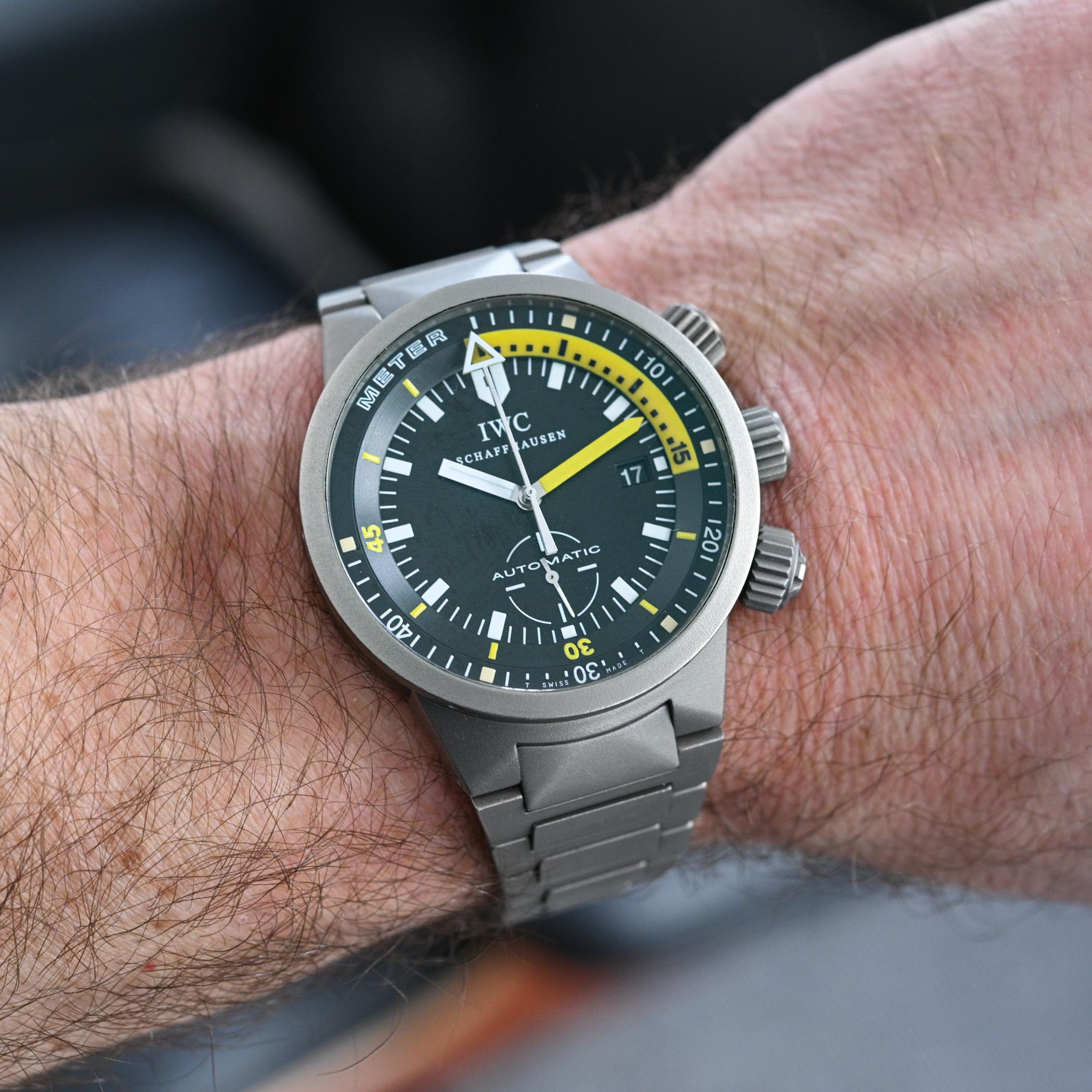

The black dial was designed with clarity as its guiding principle. Bold white printing, large Super-LumiNova-filled hour markers, and broad hands ensured readability at a glance, while the depth scale and its two distinct gauge hands stood out clearly from the time display. The date window was integrated discreetly so as not to disturb the instrument-like appearance. The running seconds subdial served as a quick visual confirmation of movement function before a dive.
Aquatimer Deep Two Ref. 3547 (2009)
Introduced in 2009, the Aquatimer Deep Two (Ref. IW3547) was IWC’s second-generation mechanical depth gauge diver, building on the GST Deep One’s concept while improving accuracy, durability, and serviceability. The new design separated the depth gauge from the main movement, enhancing reliability and making maintenance easier.
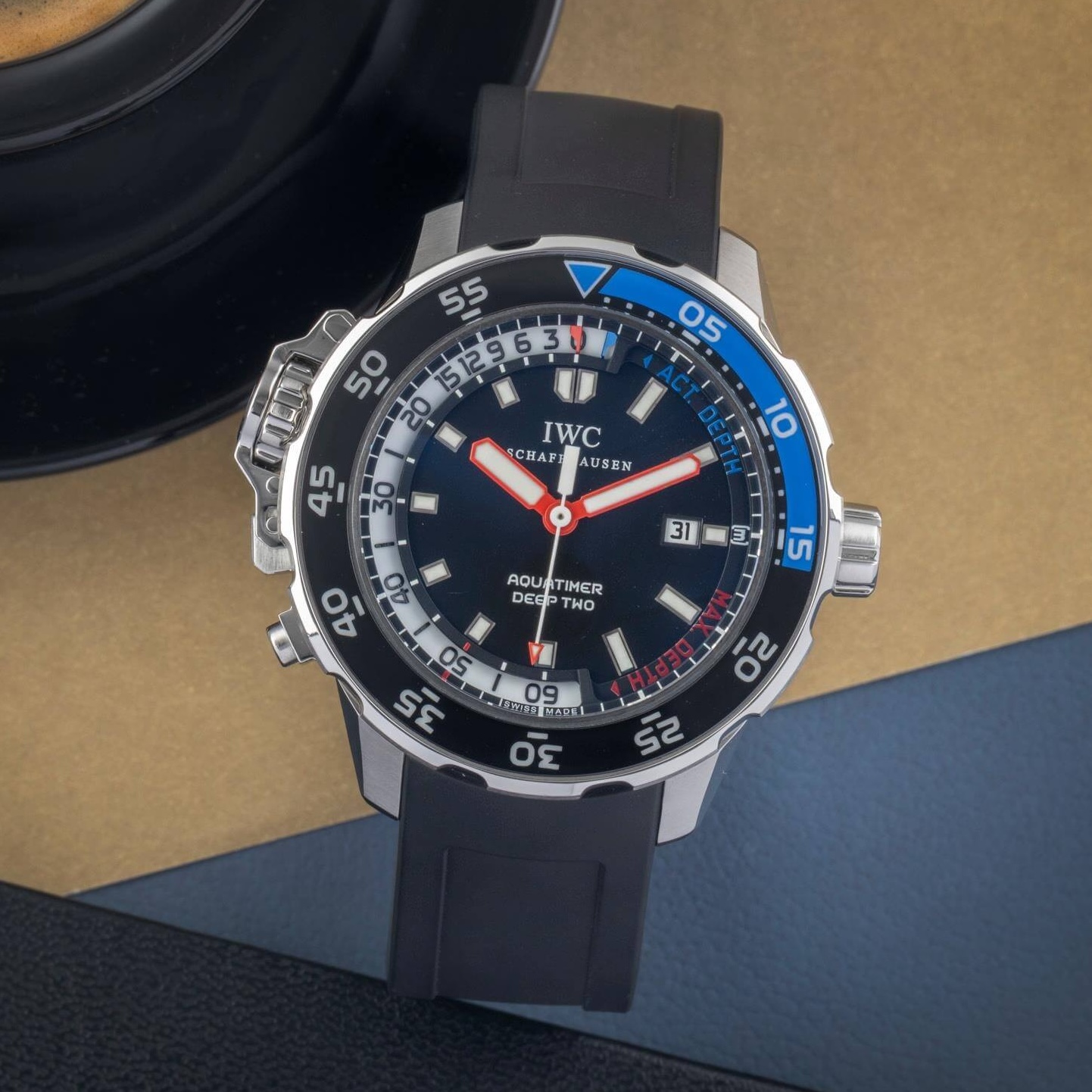

Housed in a 47.6 mm stainless steel case with a height of 15.5 mm, the Deep Two was water-resistant to 120 m, exceeding the depth gauge’s 50 m operational limit. The unidirectional external rotating bezel incorporated IWC’s SafeDive system, preventing accidental dive time extension, consisting of an outer bezel, which rotates an inner bezel via an internal gear linkage.
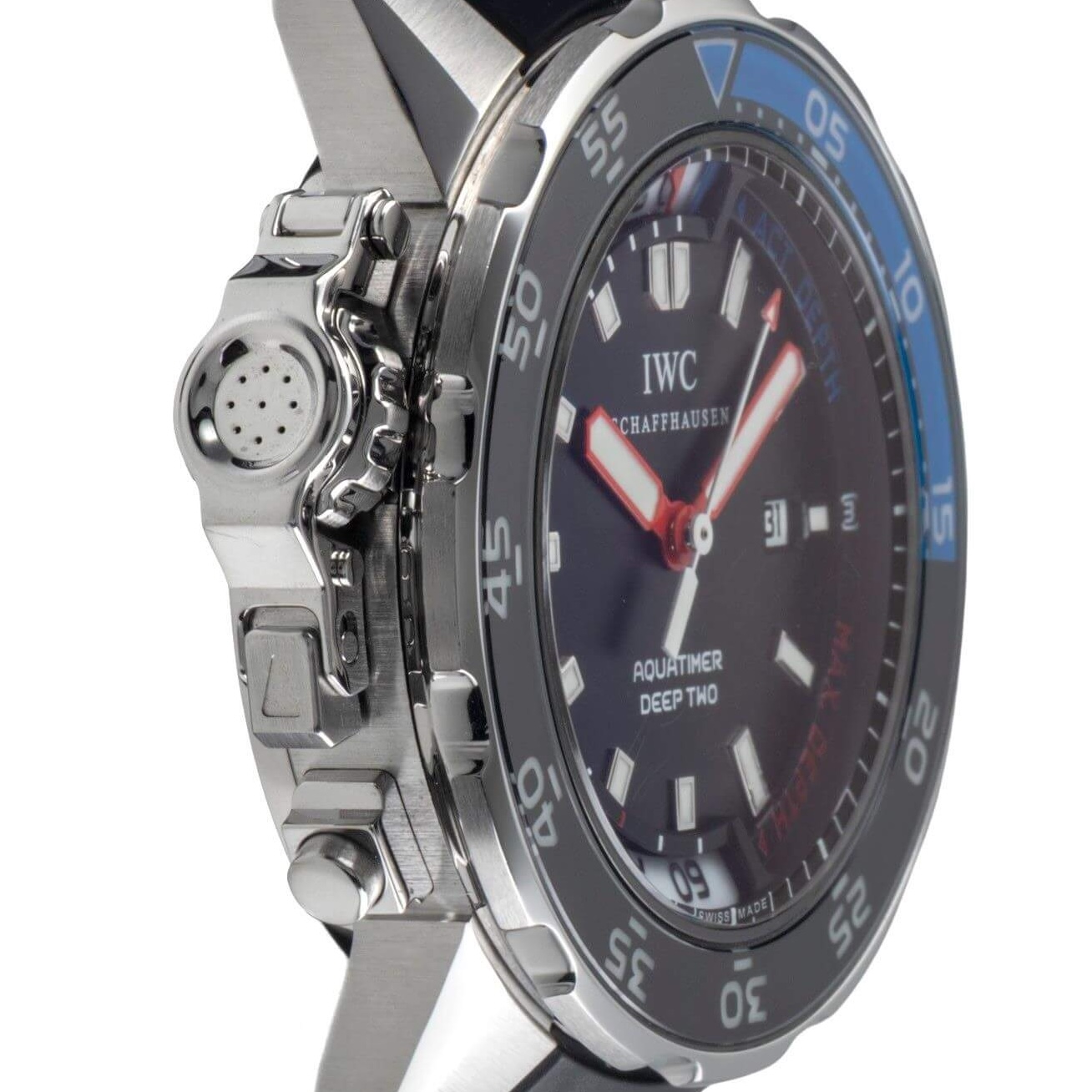

Image by Zeitauktion
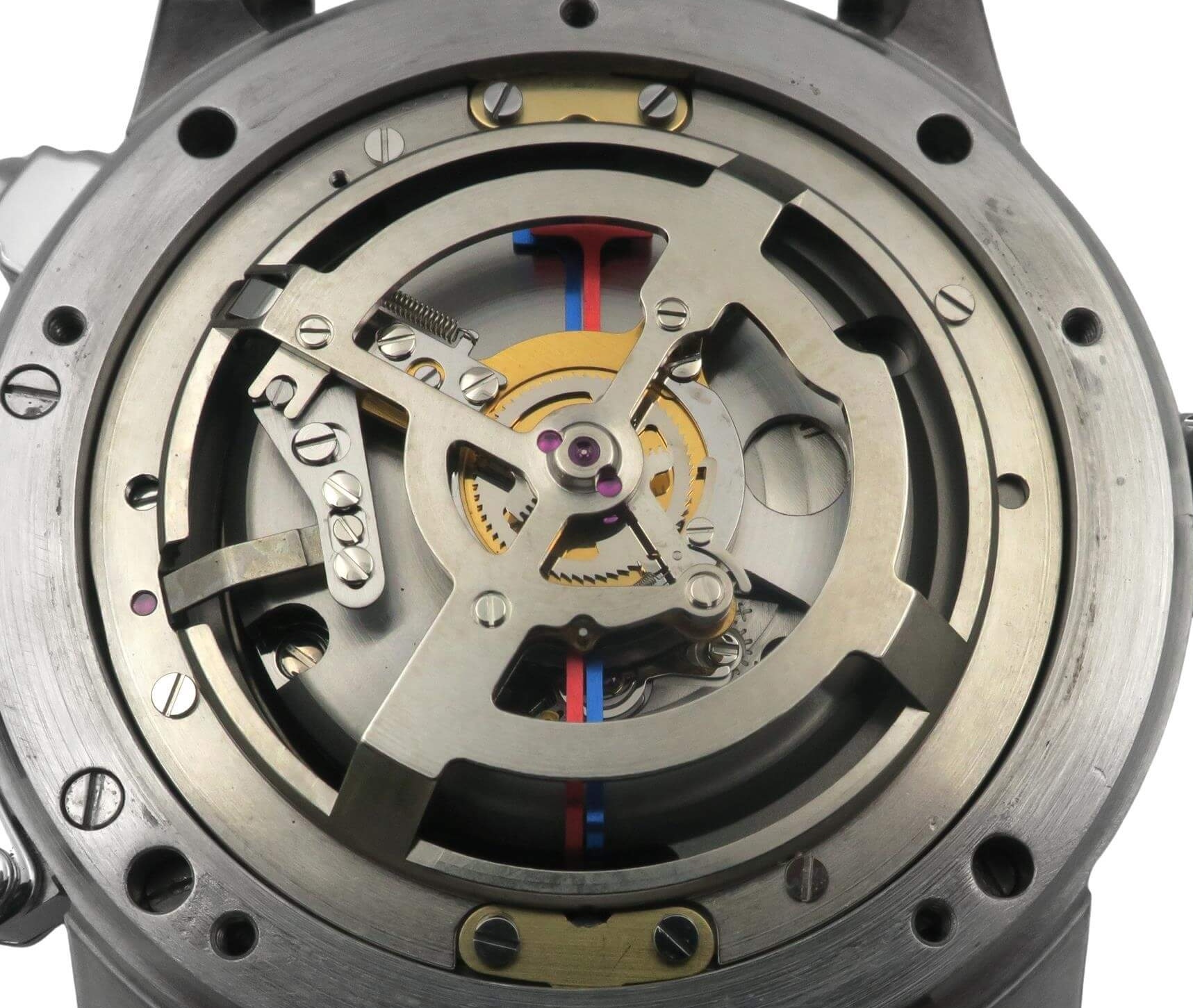

Image by Zeitauktion
The pressure-sensing system used a spring-loaded membrane, accessible via a water port on the underside of the case, linked to a rack-and-pinion transmission. This drove two indicators on the dial: a blue for real-time depth and a red for maximum depth memory, which remained fixed until reset via a pusher at 8 o’clock.
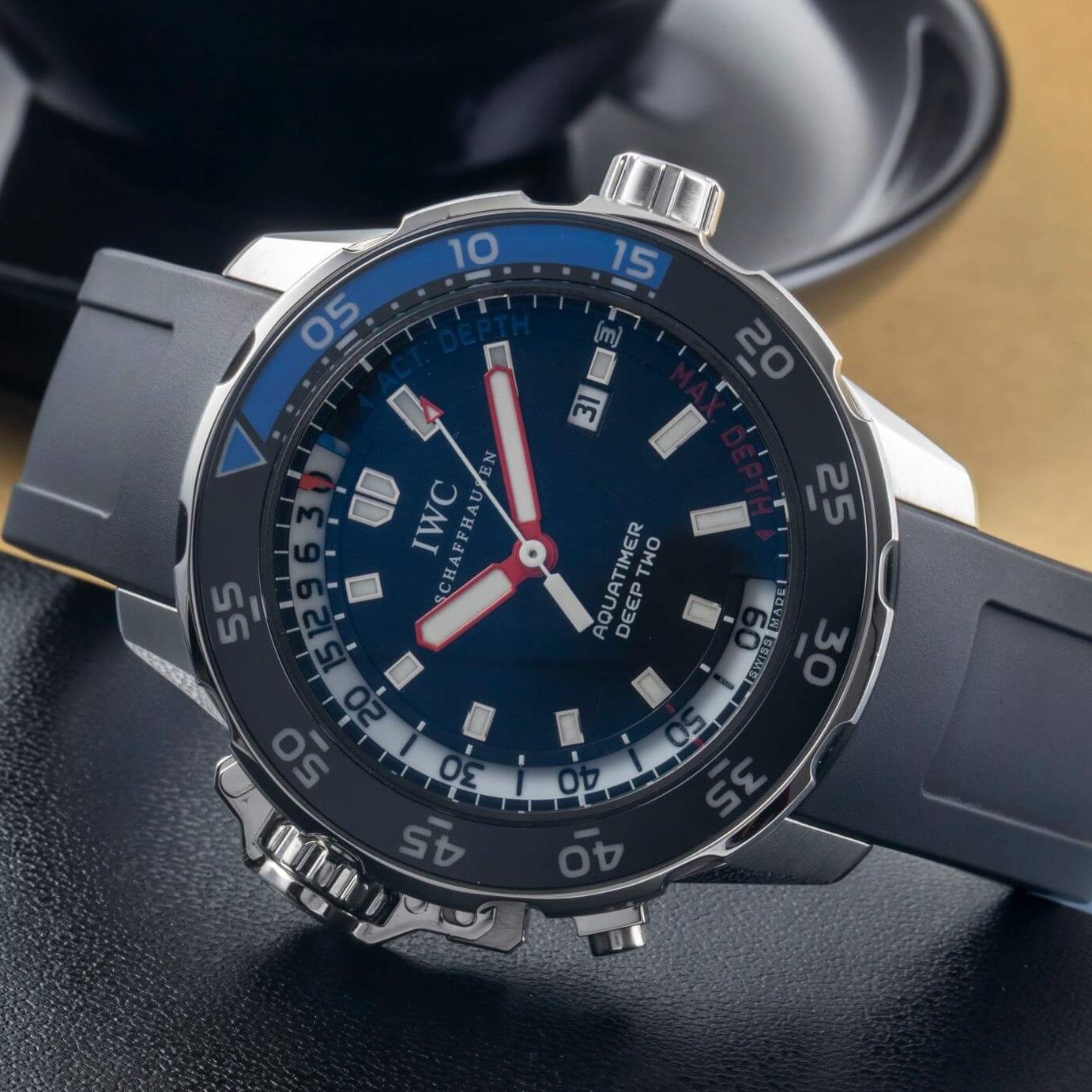

Timekeeping was handled by the automatic IWC Calibre 30110, based on the ETA 2892-A2, with a 42-hour power reserve and a frequency of 28,800 vibrations/hour. It featured central hacking seconds, a quick-set date at 3 o’clock, and bi-directional rotor winding. The movement was completely independent from the depth gauge mechanism, ensuring unaffected performance and simplifying servicing.
Aquatimer Deep Three Ref. IW355701 (2014)
Launched in 2014 during the Aquatimer line relaunch, the Deep Three represented IWC’s latest take on a mechanical depth gauge, following the Deep One (1999) and Deep Two (2009). It retained the dual-indicator system: a blue for current depth and a red for maximum depth reached, resettable via the pusher at 2 o’clock. The membrane-based gauge, mounted at 9 o’clock, drove a rack-and-pinion mechanism capable of measuring to 50 m, with extra precision in the shallow range for decompression stops.
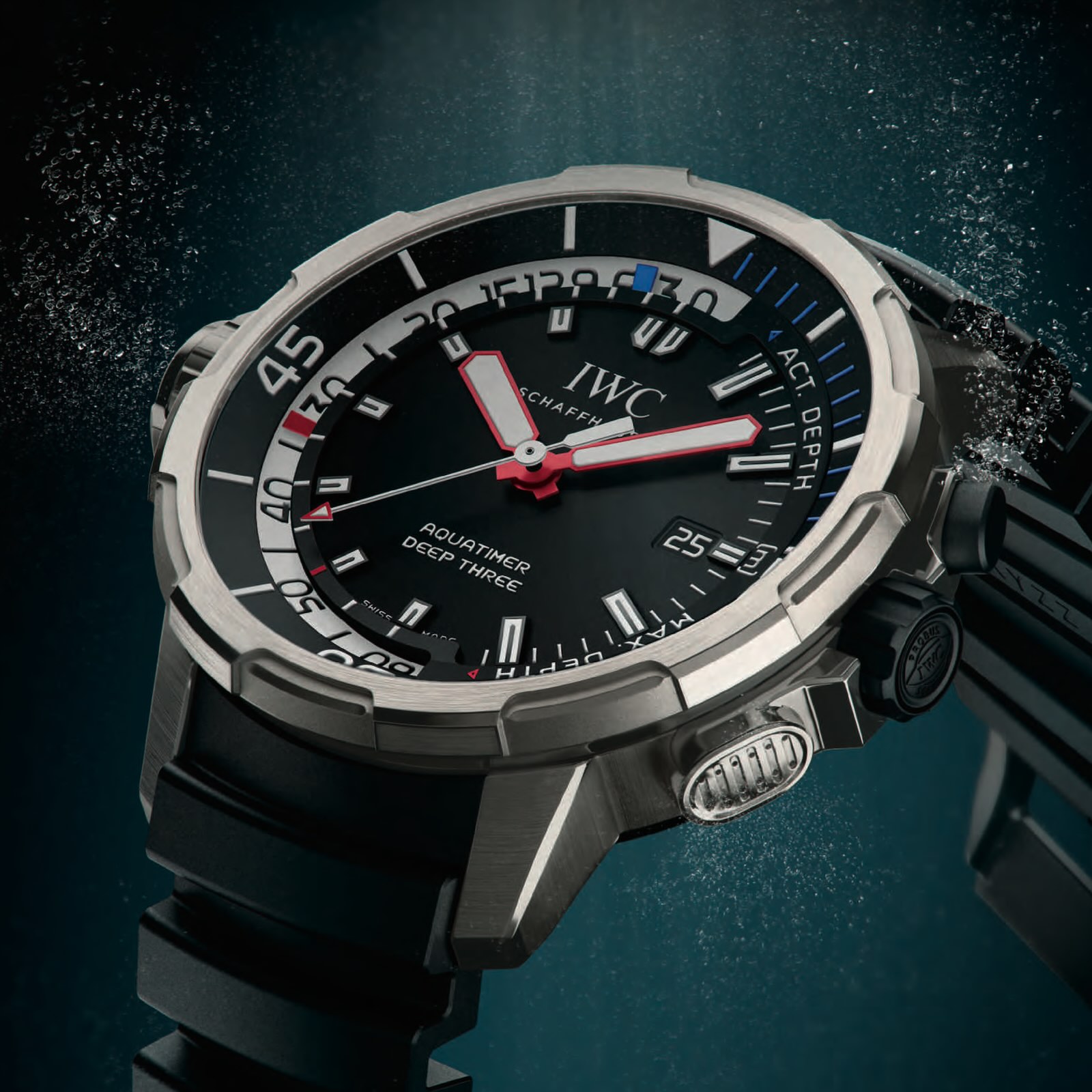

Power came from the automatic Calibre 30120, based on the ETA 2892-A2, running at 28,800 vph with a 42-hour reserve, with date at 3 o’clock, hacking seconds, and bi-directional winding. The gauge mechanism remained mechanically independent from the movement for reliability and service ease.
Its 48.4 mm titanium case measured 16.3 mm thick and was water-resistant to 100 m, well beyond the gauge’s range. IWC’s SafeDive system combined an external titanium bezel with a ceramic inlay linked to an internal unidirectional timing ring, preventing accidental extension of dive time. A convex sapphire crystal with double AR coating ensured clarity, while large Super-LumiNova-filled markers, a depth scale arc, and colour-coded indicators maximised legibility.
Measuring Time Underwater – The Aquatimer Chronographs
Aquatimer Chronograph Ref. 3719 (2004)
The launch of the Aquatimer Chronograph Ref. IW3719 marked the line’s first dedicated dive chronograph outside the GST family, blending professional underwater engineering with titanium’s lightness and strength. Measuring 41.2 mm in diameter and 14.2 mm thick, the case weighed just 128 grams and offered 120m water resistance, but the case architecture was significantly upgraded over previous IWC sports chronographs. A double-sealed crown tube reduced long-term pressure creep and protected against saltwater corrosion, while torque-optimised pusher springs maintained crisp actuation at depth or when operated with gloves. The pushers and crown were fully operational underwater, a rare achievement for mechanical chronographs.
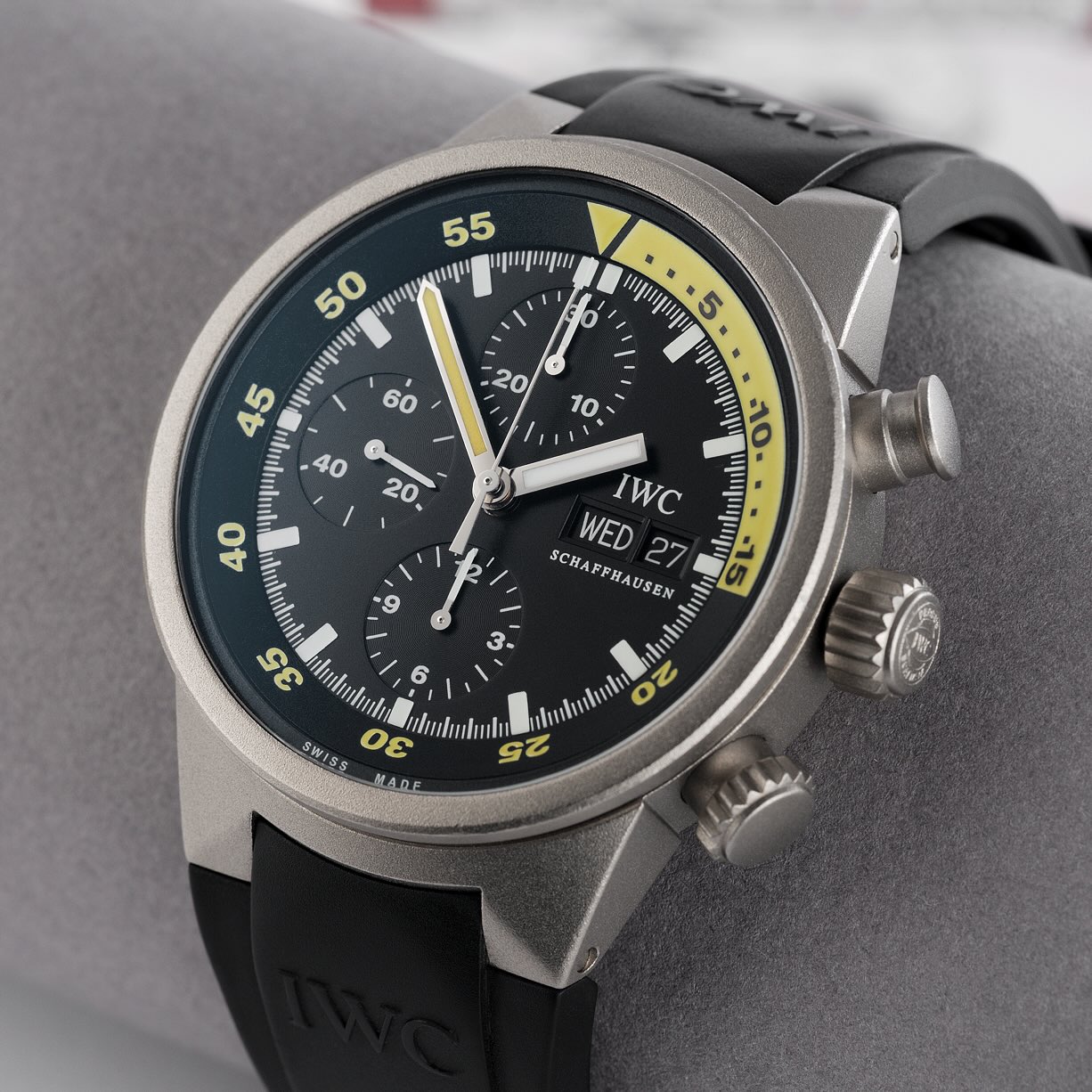

Its signature feature was the internal rotating bezel, operated by turning the lower chronograph pusher. Inside, a sealed gear train transmitted motion to the unidirectional bezel, preserving the watch’s water resistance while allowing indexed one-minute steps. The 0–15 minute sector was executed in bright yellow Super-LumiNova, a wavelength visible far deeper than red or orange light, with all bezel markings lumed for complete low-light usability.
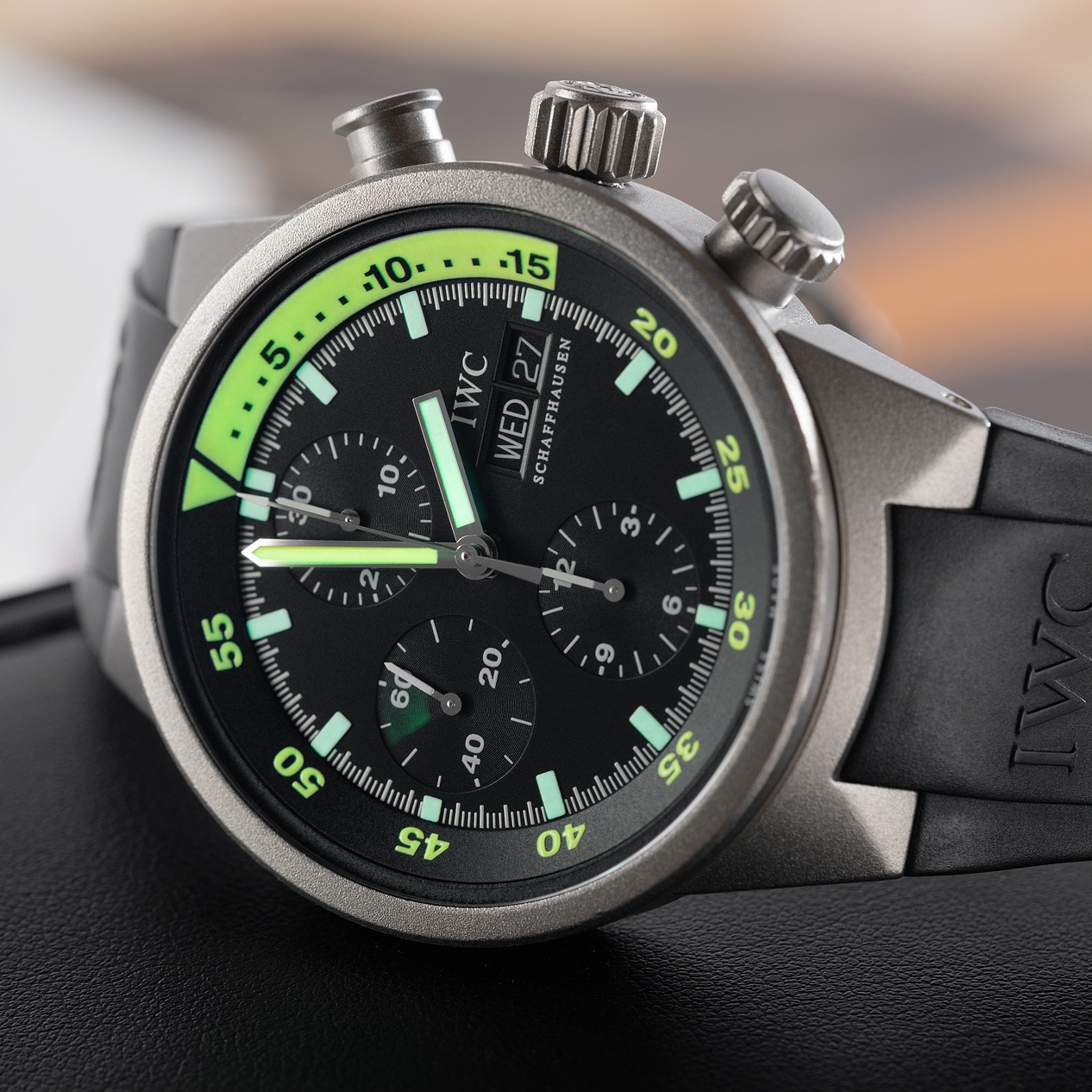

Inside was the IWC Calibre 79320, derived from the Valjoux 7750 but extensively reworked in Schaffhausen: in-house regulation, custom gear train finishing, and an engraved rotor. The movement offered a 44-hour power reserve at 28,800 vibrations/hour, with a classic tri-compax layout, day-date display, and proven shock resistance.
Aquatimer Split Minute Chronograph Ref. 3723 (2004)
Launched in 2004, the Aquatimer Split Minute Chronograph introduced a unique rattrapante-style complication to the professional diver’s watch segment. Powered by the automatic IWC Calibre 79470, again a much-modified Valjoux 7750, the watch allowed elapsed time measurement in three ways: via the internal unidirectional bezel, the main chronograph, and a patented split-minute flyback hand for recording multi-stage dive times.
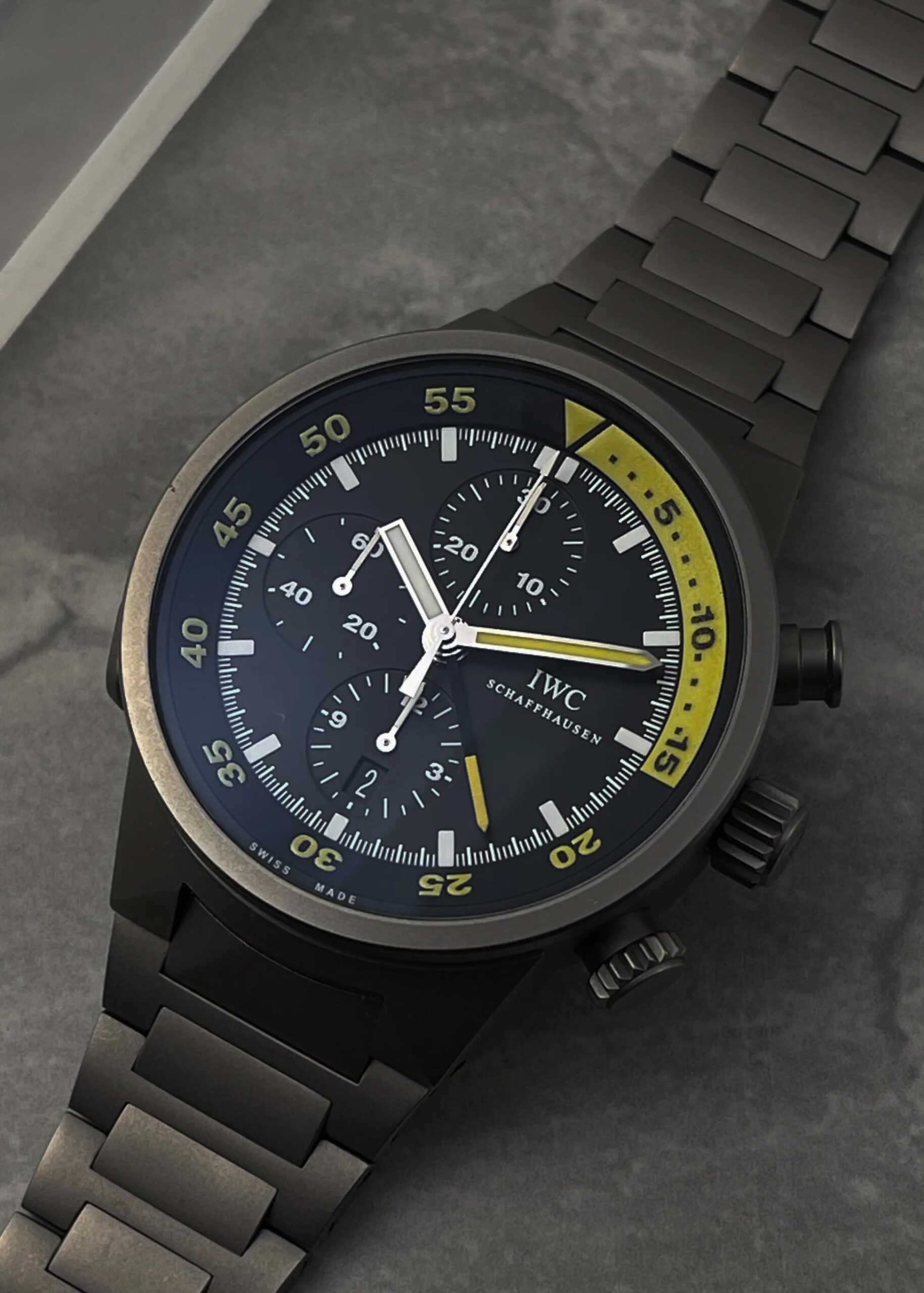

The second chronograph minute hand could be stopped independently to record a lap or decompression stop, then released to instantly rejoin the running minute counter without interrupting overall timing. Standard chronograph functions included central chronograph seconds, a 30-minute counter at 12 o’clock, a 12-hour counter at 6 o’clock, and small seconds at 9 o’clock. The Calibre 79470 movement beat at 28,800 vibrations/hour, featured a 44-hour power reserve, hacking seconds, and decorative Côtes de Genève finishing.
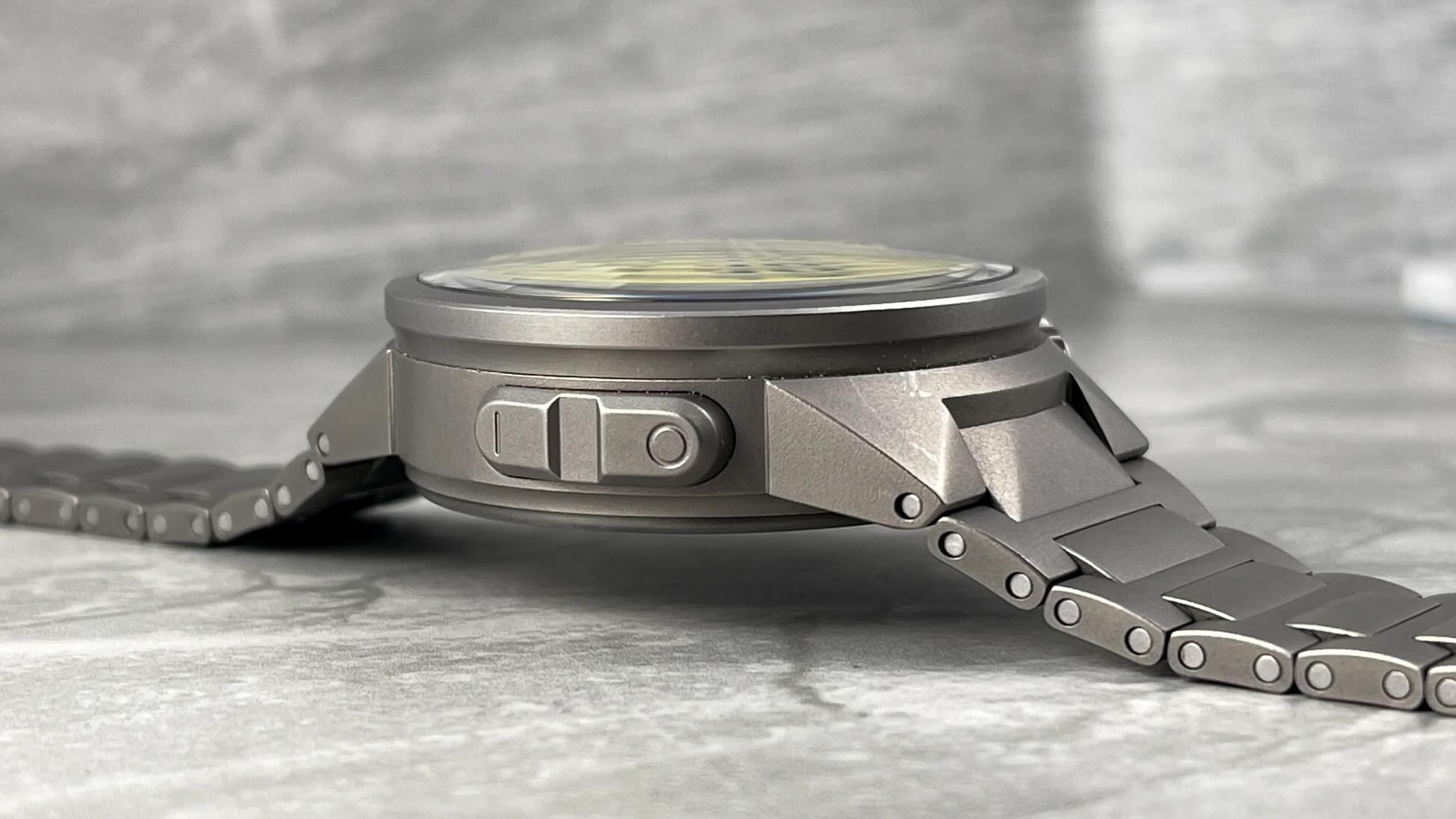

The 43.8 mm titanium case, 16.3 mm thick, was engineered for both lightness and strength, with water resistance to 120 m. It incorporated IWC’s mechanical external/internal rotating bezel with the SafeDive system, ensuring one-way rotation for dive safety. A convex sapphire crystal with an anti-reflective coating on both sides provided clarity in all lighting conditions.
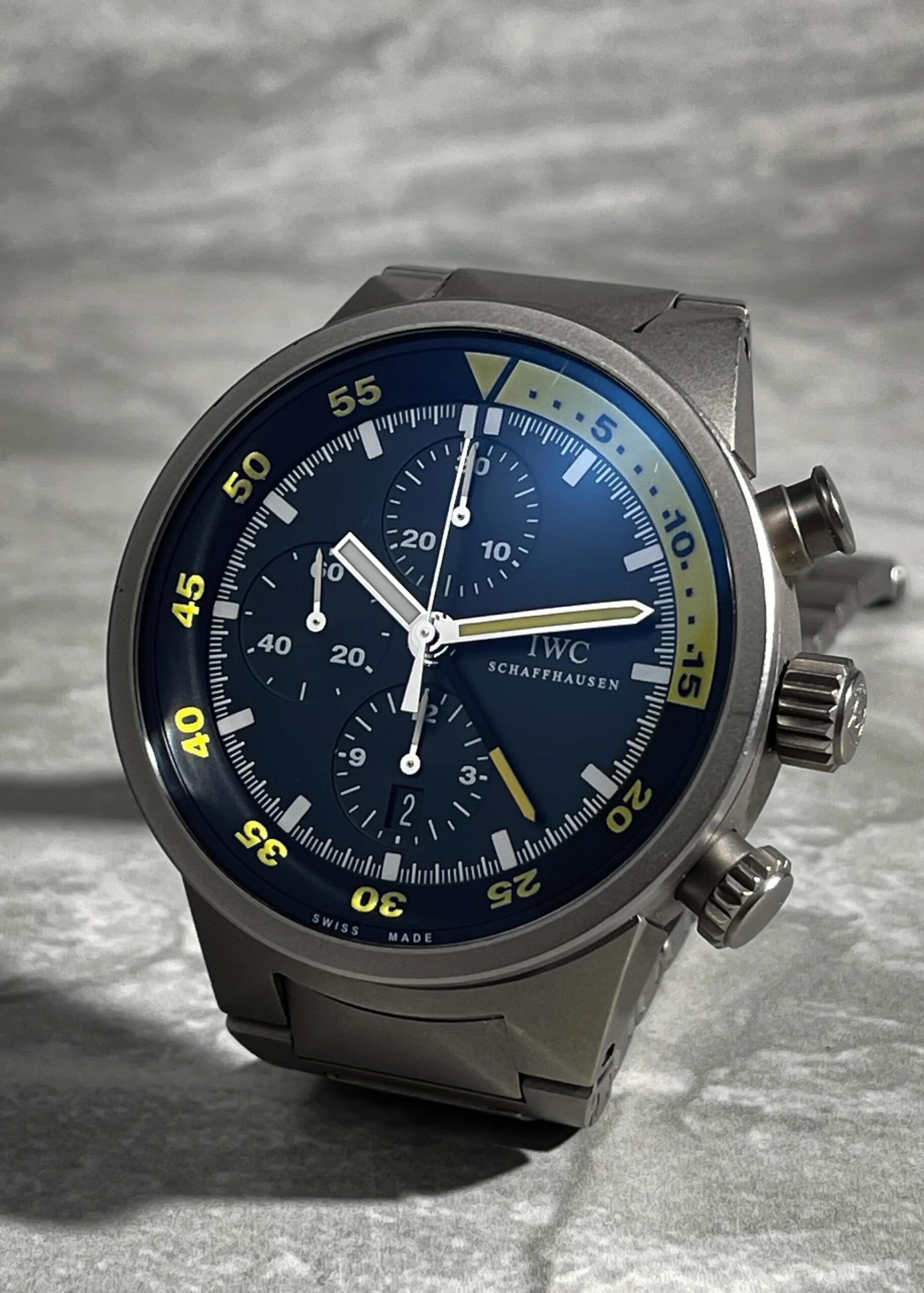

The black dial was designed for underwater legibility, with bold Super-LumiNova-coated hands and markers, and a prominent split-minute hand for instant recognition of intermediate times. The watch was paired with a titanium bracelet for durability and hypoallergenic comfort. By combining a patented diving-specific rattrapante with robust case engineering, the Aquatimer Split Minute Chronograph delivered a professional-grade utility, cementing IWC’s reputation for innovation in the Aquatimer line.
IWC Aquatimer Chronograph Ref. 3767 (2009)
In 2009, the Aquatimer Chronograph underwent a radical redesign with the debut of the Ref. IW3767, replacing the internal bezel with a newly engineered external system. The 43.5 mm stainless steel case, 15.2 mm thick, preserved the 120m water resistance rating but introduced the SafeDive system, a sealed mechanical coupling that allowed the external bezel to rotate the internal timing scale without compromising the case’s integrity. This coupling, hidden beneath the bezel, was exceptionally rare in dive watch engineering.
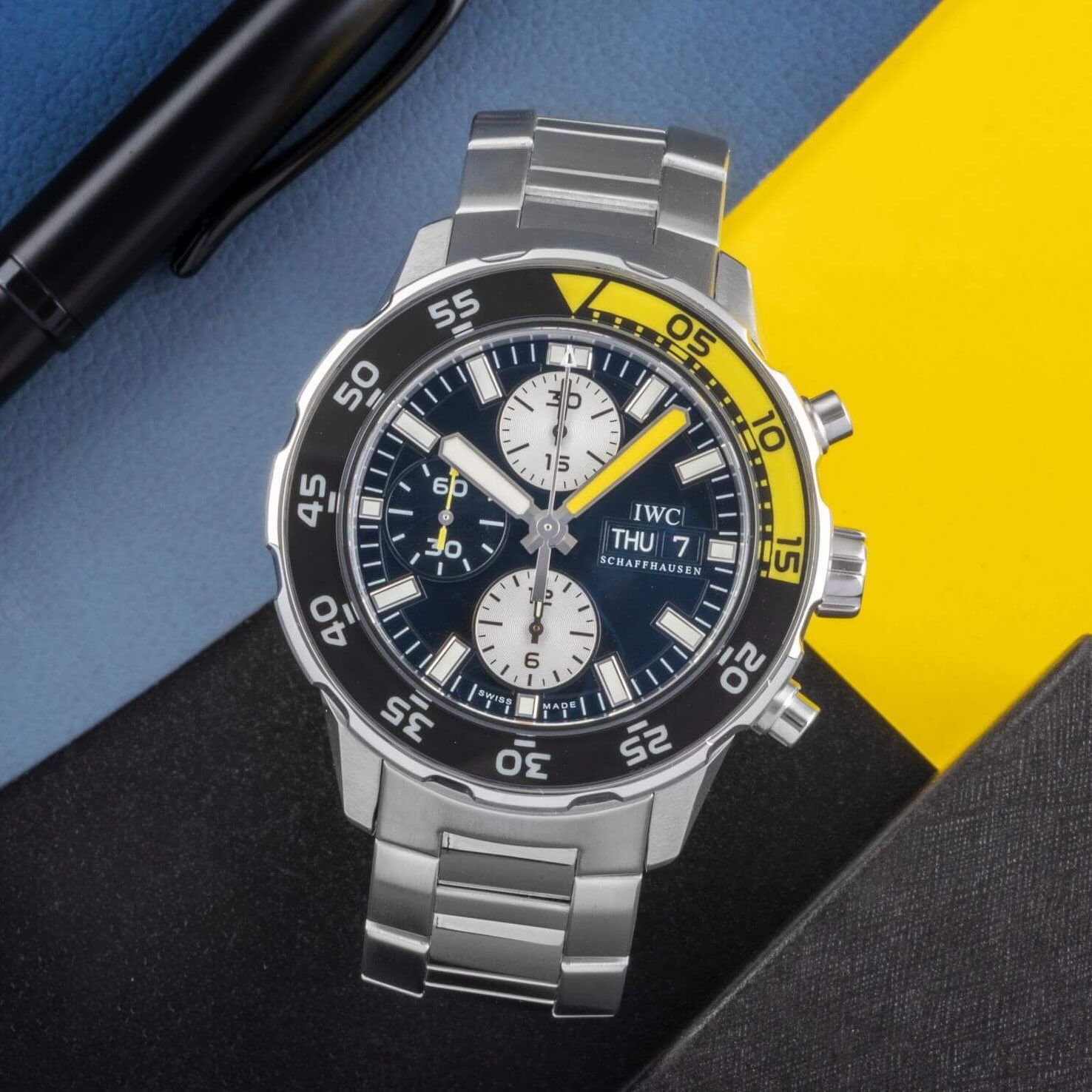

The bezel was topped with a 4mm sapphire insert, beneath which lay a deeply lumed minute scale applied in six layers of Super-LumiNova. The first quarter-hour was marked in high-contrast yellow for decompression stop timing, chosen for its visibility in low-light underwater environments. The system’s tactile ratcheting allowed precise minute indexing even with gloves.
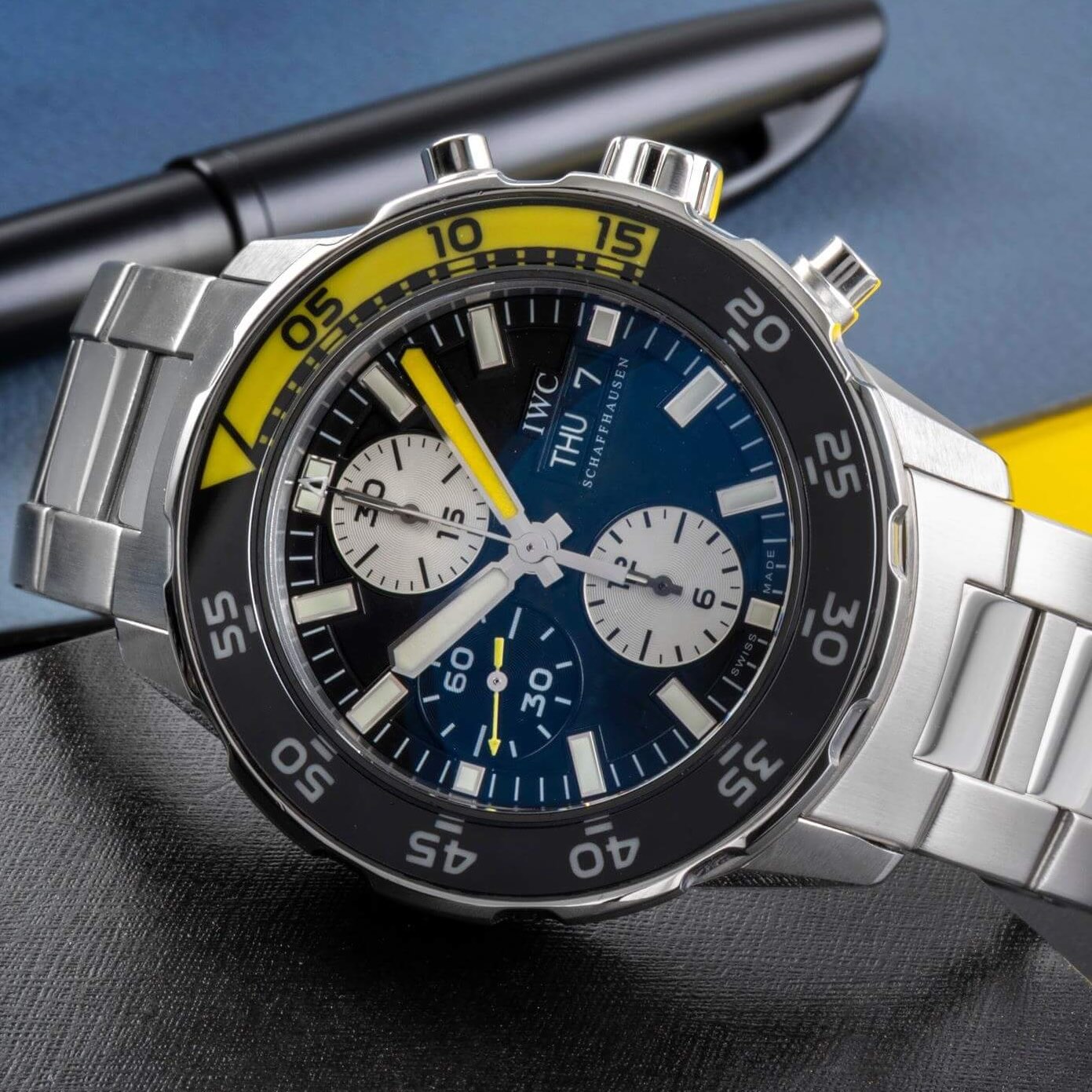

The dial was refined with colour-matched chronograph subdials, improving visual balance. The Calibre 79320 stayed, retaining its IWC-tuned 7750 base, with the same regulation and custom finishing as the 3719. Crown tubes and pusher assemblies are carried over the torque-optimised spring system for reliable actuation under water pressure. More editions were later available, in blue, with orange accents, or with a black coated case.
IWC Aquatimer Chronograph Ref. 3768 (2014)
The Ref. IW3768, introduced in 2014, built on the 3767’s engineering but placed the Aquatimer Chronograph into professional diving territory. The stainless steel case grew to 44 mm in diameter and 17 mm thick, with water resistance upgraded to 300 m. This was achieved through thicker case walls, reinforced seals in the SafeDive coupling, and a multi-gasket crown system.
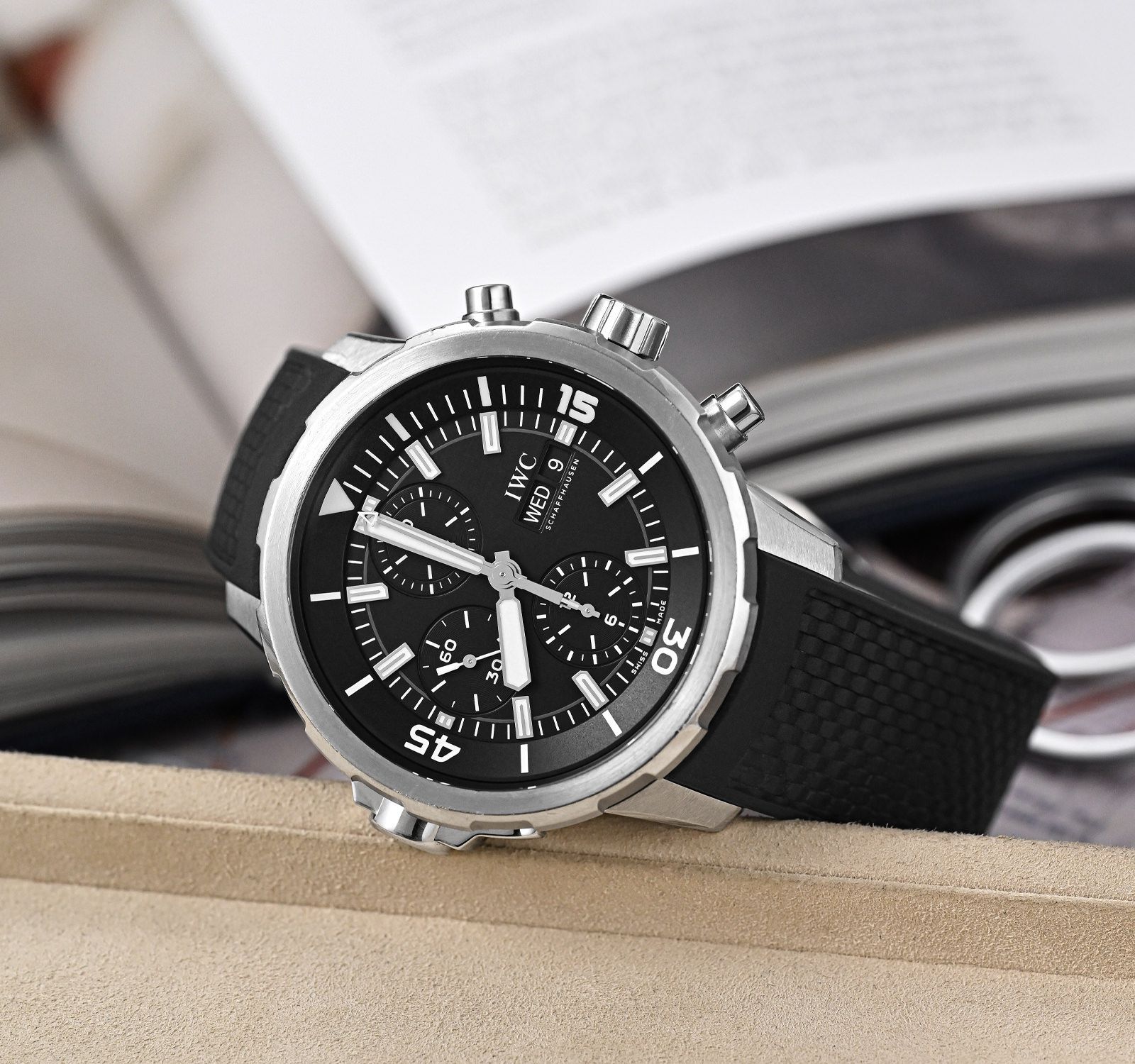

The SafeDive system was retained, but with a fully lumed internal scale. The first 15 minutes of the scale remained in high-contrast colour (yellow, or later blue/white) for safe decompression stop timing. The sealed mechanical coupling remained a standout feature, combining tactile precision with uncompromised water resistance.
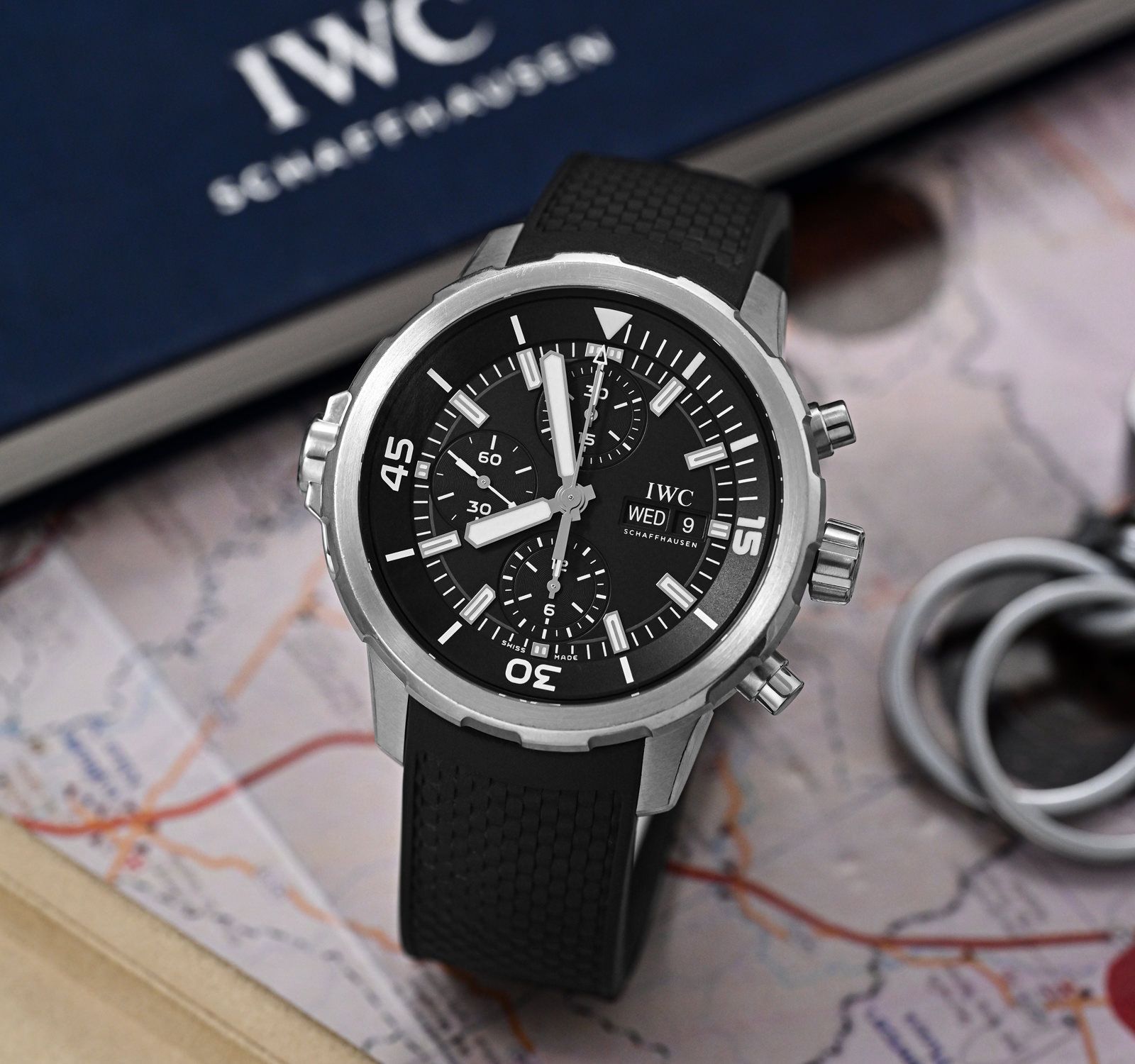

The Calibre 79320 continued as the power source, its Valjoux 7750 base tuned in-house by IWC for regulation stability, durability, and decorated finishing. Torque-optimised pusher springs were retained for a consistent chronograph feel at any depth. With its enhanced depth rating, fully lumed timing scale, and mature SafeDive implementation, the IW3768 represented the technical peak of the Aquatimer Chronograph lineage and is part of the current collection.
The modern Aquatimer Automatic models
While it might seem from our narrative that the “simple” time and date IWC dive watches were missing after the inaugural Aquatimer references, this is not true, so let us mention a few important watches from the past decades and complete the story by mentioning the Aquatimer Automatic Collection, updated in 2022, and which stays current today.
IWC Aquatimer Automatic – Ref. 3538 and 3548 (2004)
Introduced in 2004, the IWC Aquatimer Automatic Ref. IW3538 (titanium, 2000m) and IW3548 (steel, 1000m marked a deliberate return to the model’s 1967 roots, reintroducing the internal rotating bezel as its defining feature. The 42 mm stainless steel case of the 3548, measuring approximately 13 mm thick, combined a compact profile with extreme durability, achieving a water resistance rating of 1000m. This level of pressure resistance, rare for a watch of this size, was made possible by a multi-gasket sealing system, a screw-in case back, and twin screw-down crowns, one at 2 o’clock for time setting, the other at 4 o’clock dedicated to the internal bezel.
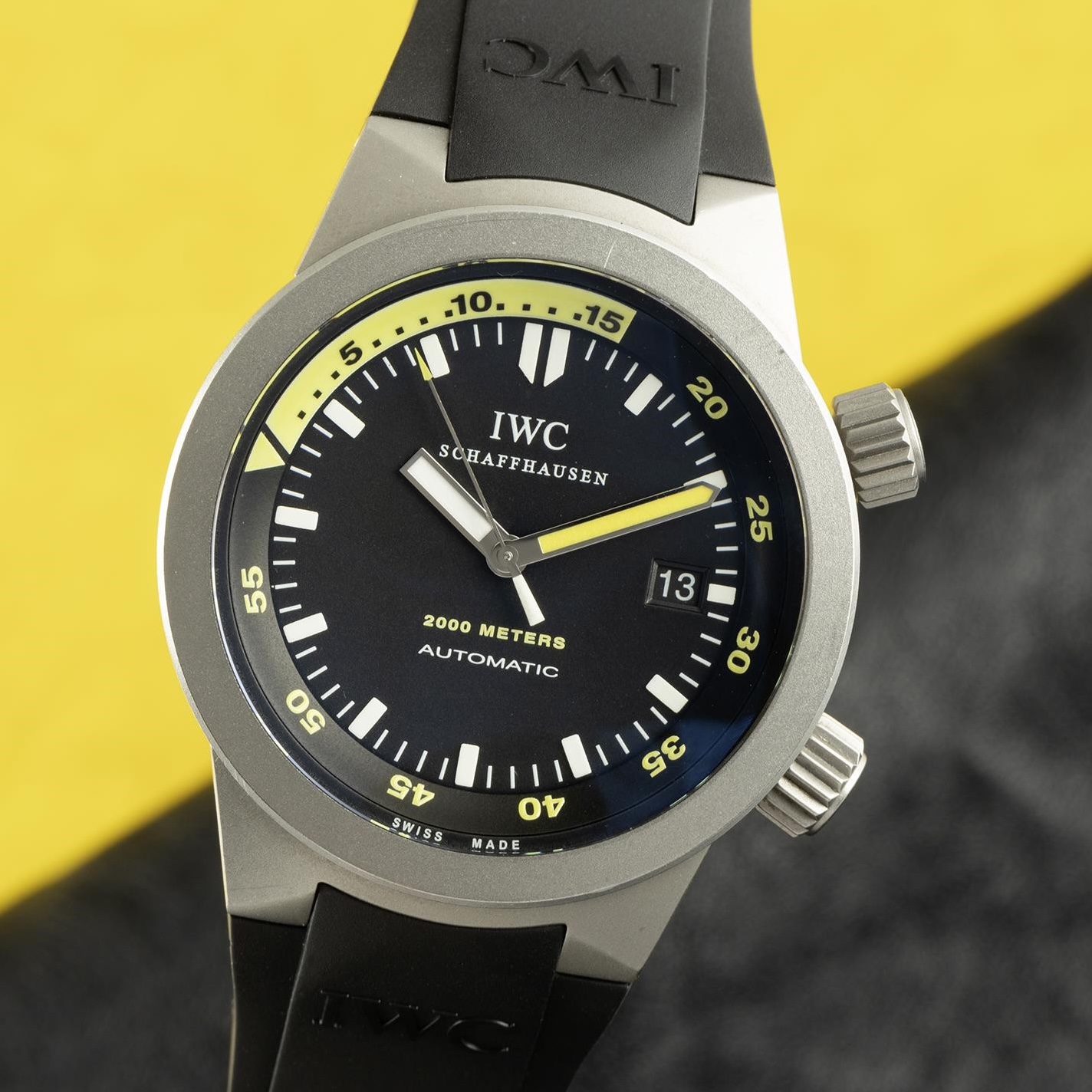

The bezel was precise and functional, with one-minute indexing and a luminous 15-minute dive scale. Its internal placement prevented accidental rotation and impacts, an evolution of the Aquatimer’s original concept. The dial featured applied baton indices filled with luminous material, complemented by luminous hands, and a date display discreetly positioned at 3 o’clock.
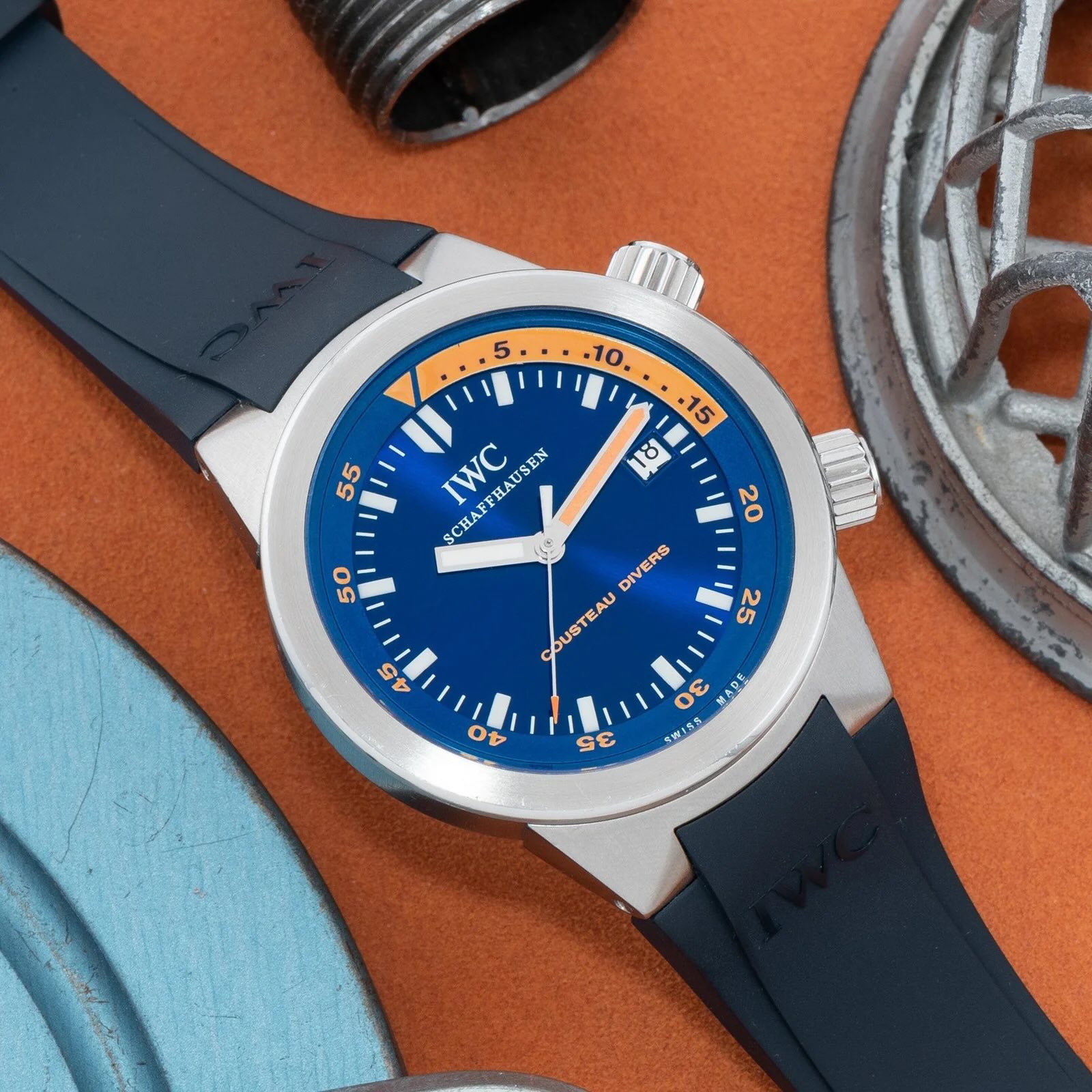

The watch was powered by the IWC Calibre 30110, a high-grade automatic movement based on the ETA 2892-A2. It offered a 42-hour power reserve, quick-set date, hacking seconds, and bi-directional winding via a smooth and robust rotor system. Each movement was regulated to IWC’s standards for precision and reliability.
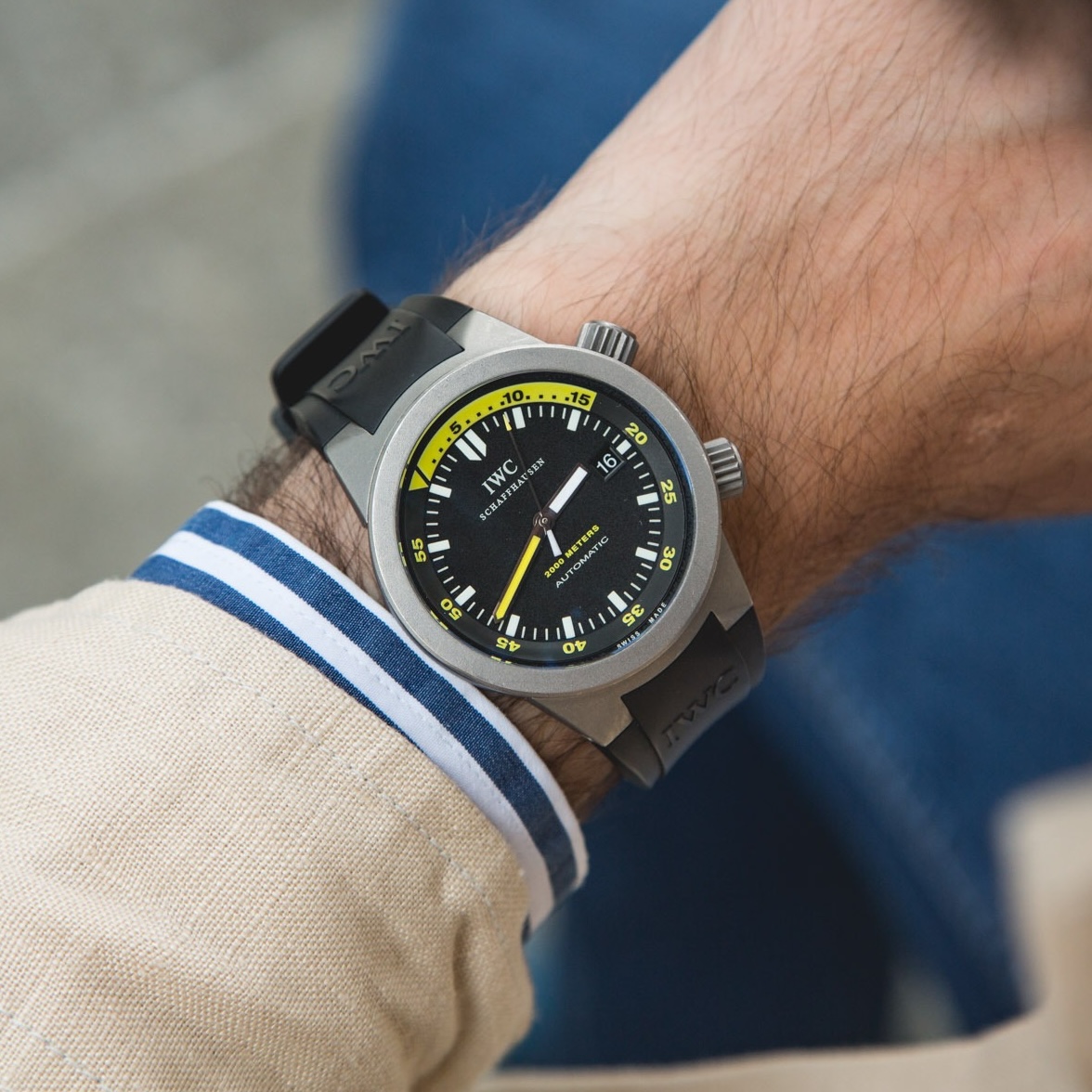

The watch’s balanced dimensions and relatively slim build made it one of the most wearable professional-grade divers of its time, bridging the gap between historical inspiration and modern engineering in the Aquatimer lineage.
Aquatimer Automatic 2000 Ref. 3568 (2009)
Released in 2009, the Aquatimer Automatic 2000 (Ref. IW3568) replaced the internal-bezel 3538 with a conventional external unidirectional bezel, while maintaining the 2000m water resistance. The 44 mm stainless steel case, 14 mm thick, uses a screw-down crown, reinforced screw-back, and multi-gasket sealing system to achieve saturation-diving depth without a helium escape valve.
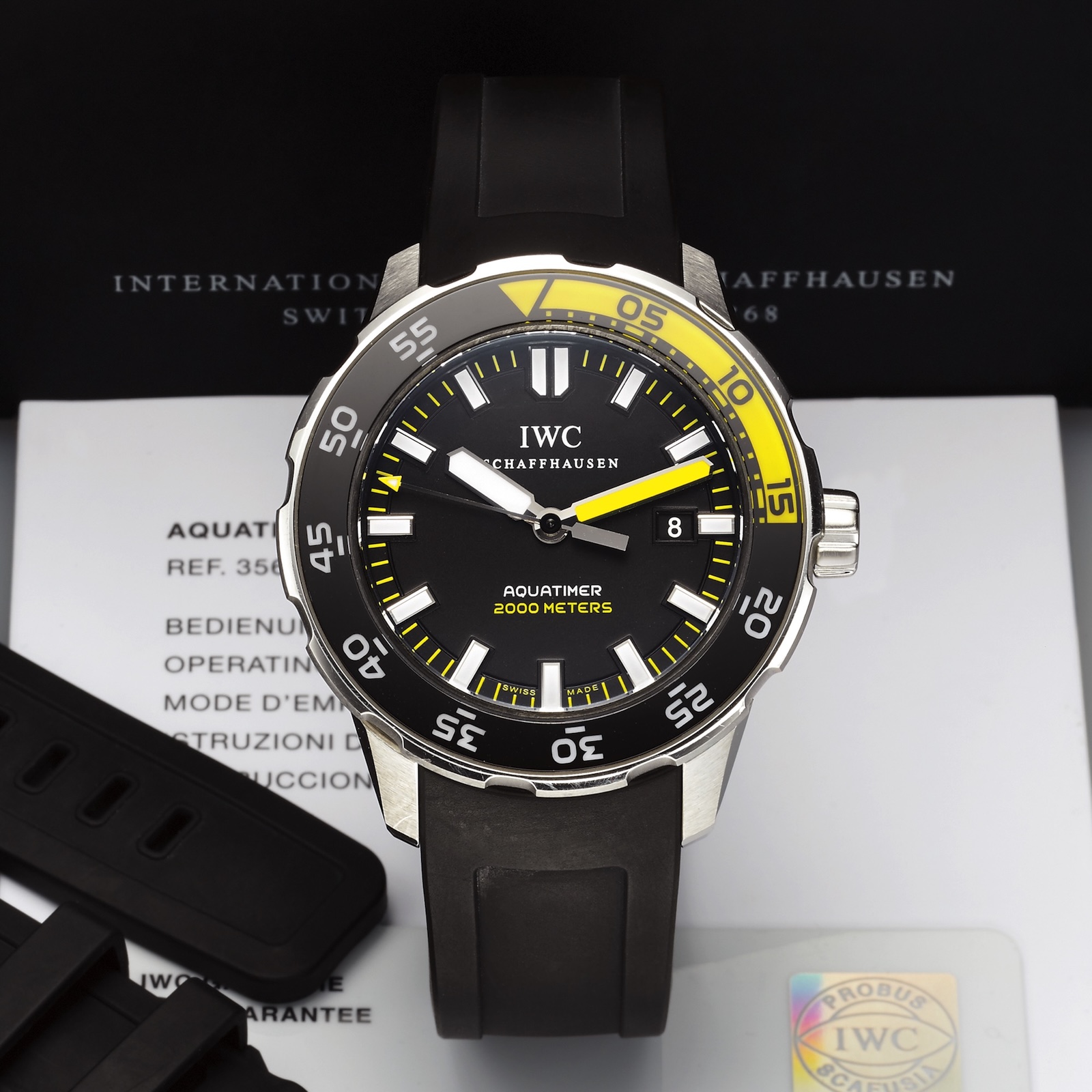

The bezel insert is sapphire, coated with underside-applied Super-LumiNova, ensuring permanent scratch resistance and high visibility. The first 15 minutes are marked in signal yellow for decompression timing, matching the yellow-filled minute hand. The dial was matte black with applied luminous indices, a recessed date at 3 o’clock, and a domed sapphire crystal with double AR coating. The watch was powered by the IWC Calibre 30110 (ETA 2892-A2 base), just like its predecessor.
IWC Aquatimer Automatic 2000 Ref. 3580 (2014)
The Aquatimer Automatic 2000 Ref. IW3580 was engineered to survive pressures found at depths of up to 2000 m, continuing the legacy of ultra-deep divers that began with the Porsche Design Ocean 2000 in 1982. The watch featured a titanium case measuring 46.0 mm in diameter and 20.9 mm in height, chosen for its exceptional strength-to-weight ratio, corrosion resistance, and hypoallergenic properties. Water resistance is ensured by a multi-layer case structure, heavy-duty case back, screw-in crown, and a system of high-compression gaskets designed to maintain sealing integrity under massive static and dynamic pressures.
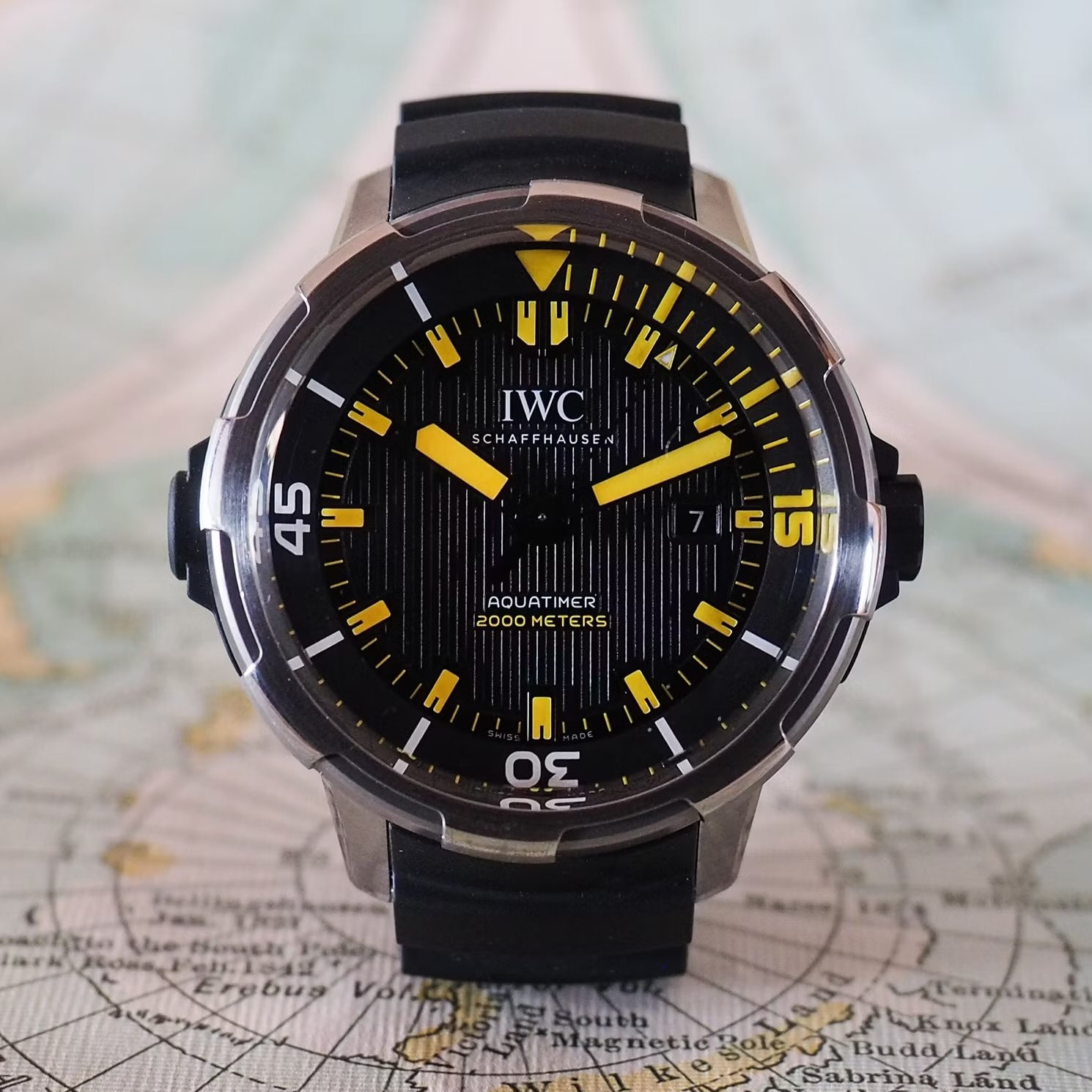

A key feature is IWC’s SafeDive system, which mechanically couples an external unidirectional bezel to an internal timing ring via a sealed gear train housed at the 9 o’clock position. This design keeps the gearing protected from water and debris while ensuring that elapsed time can never be extended accidentally-only shortened. The convex sapphire crystal, anti-reflective coated on both sides, is secured to withstand severe deformation forces at depth.
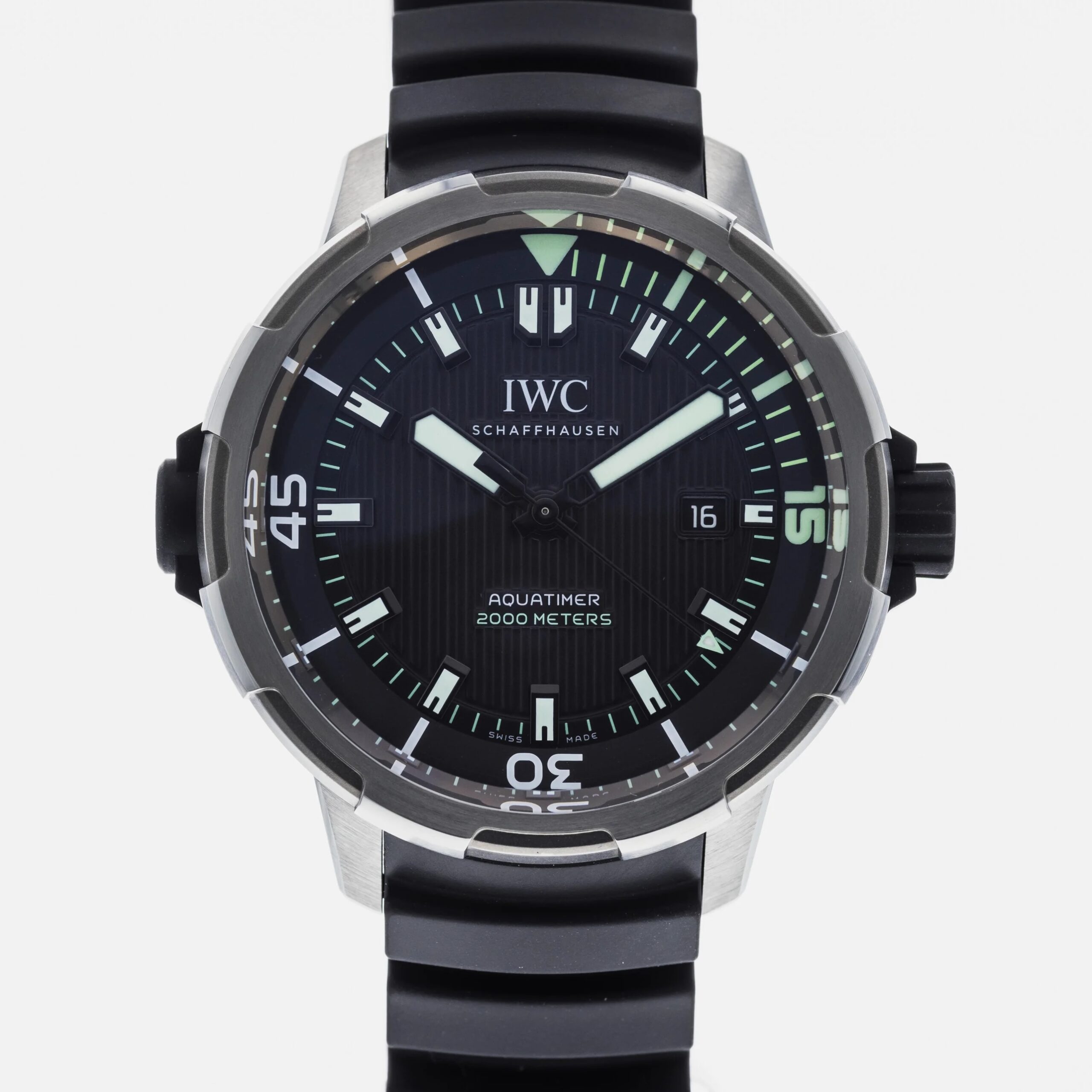

Powering the Aquatimer Automatic 2000 was the IWC-manufactured Calibre 80110, a 28-jewel automatic movement with 218 components, operating at 28,800 vibrations/hour. It incorporated the brand’s Pellaton winding system for efficient bidirectional winding, delivered a 44-hour power reserve, and included central hacking seconds and a date display. The movement is mounted within an internal pressure-resistant housing, further isolating it from environmental stress.
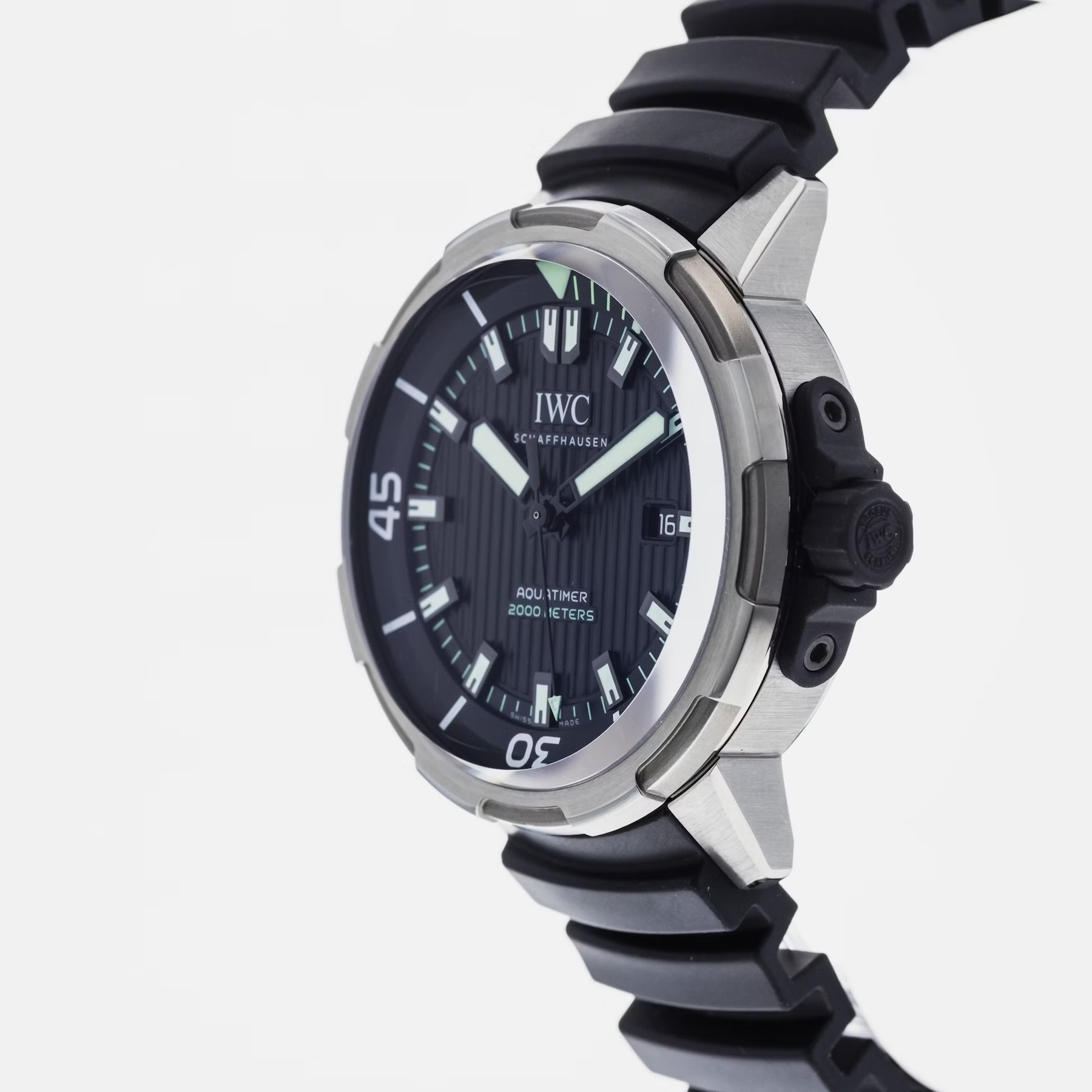

Image by Hodinkee Shop
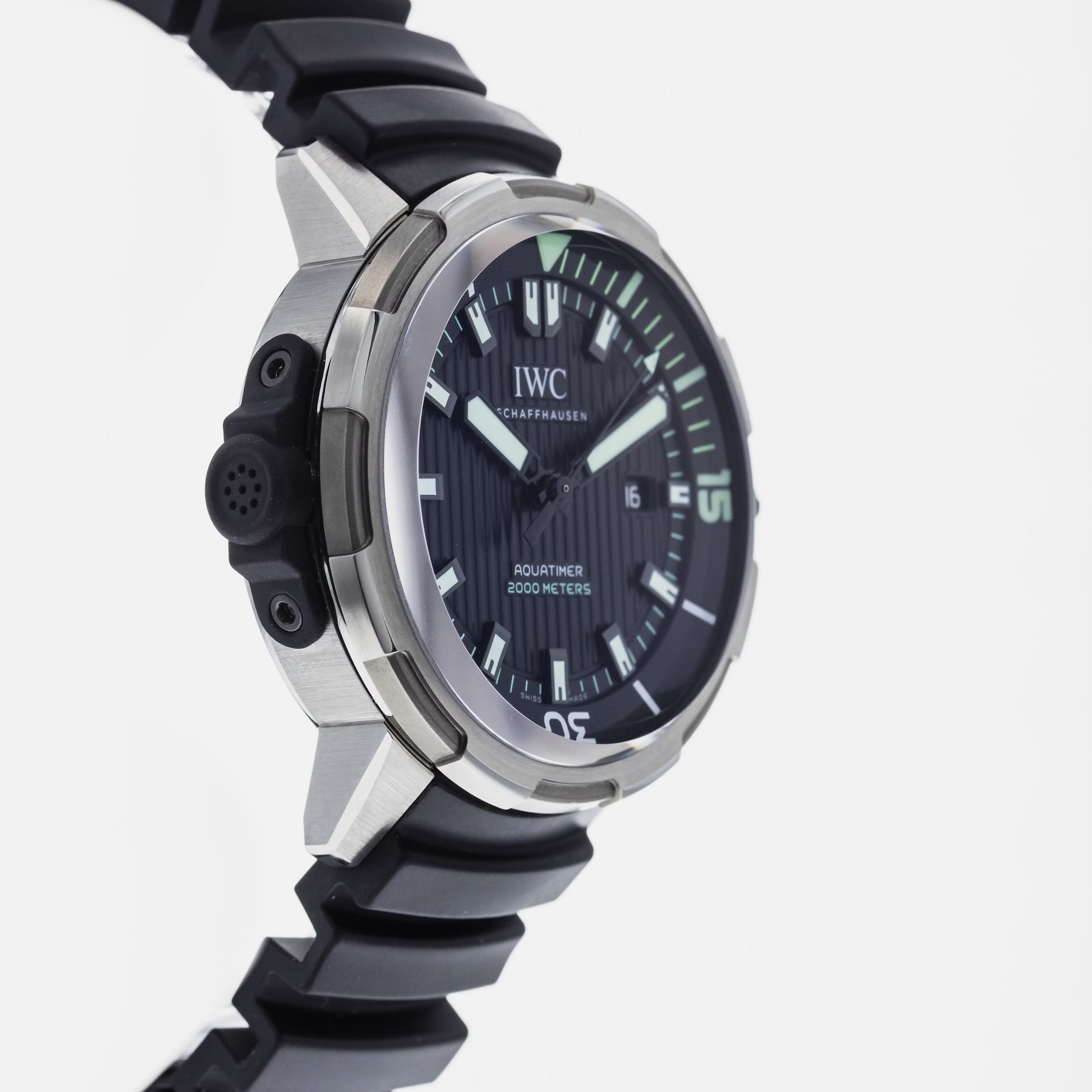

Image by Hodinkee Shop
The black dial was laid out for maximum clarity: bold Super-LumiNova-coated hands and indices, a fully lumed internal scale for dive timing, and a contrasting 0–15 minute arc on the timing ring for decompression stop monitoring. With its 2000m depth rating, titanium case, and in-house movement, the Ref. IW3580 was over-engineered for human diving limits, yet proved IWC’s continuing capability in producing professional-grade underwater instruments.
Aquatimer Automatic Ref. 3288 (2022)
The 2022 update to the Aquatimer Automatic marked a meaningful evolution in this classic dive watch series. For years, the Aquatimer remained somewhat under the radar, overshadowed by IWC’s more aggressively promoted Pilot’s and Portugieser lines. Yet its classic dive watch aesthetics, robust build quality, and distinctive internal rotating bezel have long made it a quietly compelling option among enthusiasts. The introduction of a new movement significantly enhanced performance without altering the familiar design.
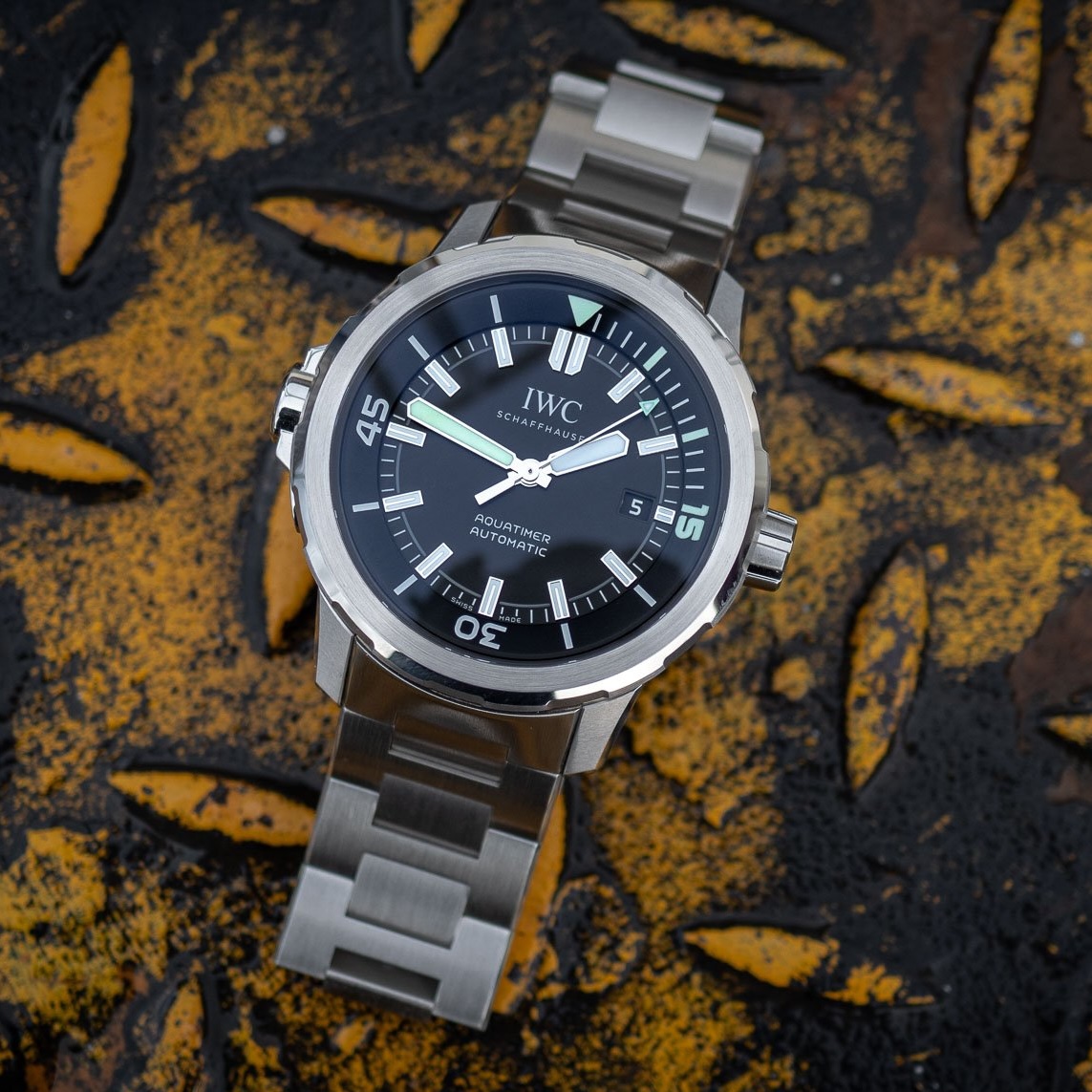

Measuring 42 mm in diameter and 14.1 mm thick, the case has the signature Aquatimer shape and the patented SafeDive system. Unlike conventional compressor-style dive watches, where a secondary crown manually rotates the internal bezel, the Aquatimer’s bezel system uses a clever mechanical coupling at 9 o’clock that turns the internal scale simply by rotating the external bezel, eliminating any risk associated with unscrewing a crown underwater. The watch offers 300 meters of water resistance and features a screw-down crown and caseback, further underlining its tool-watch credentials.
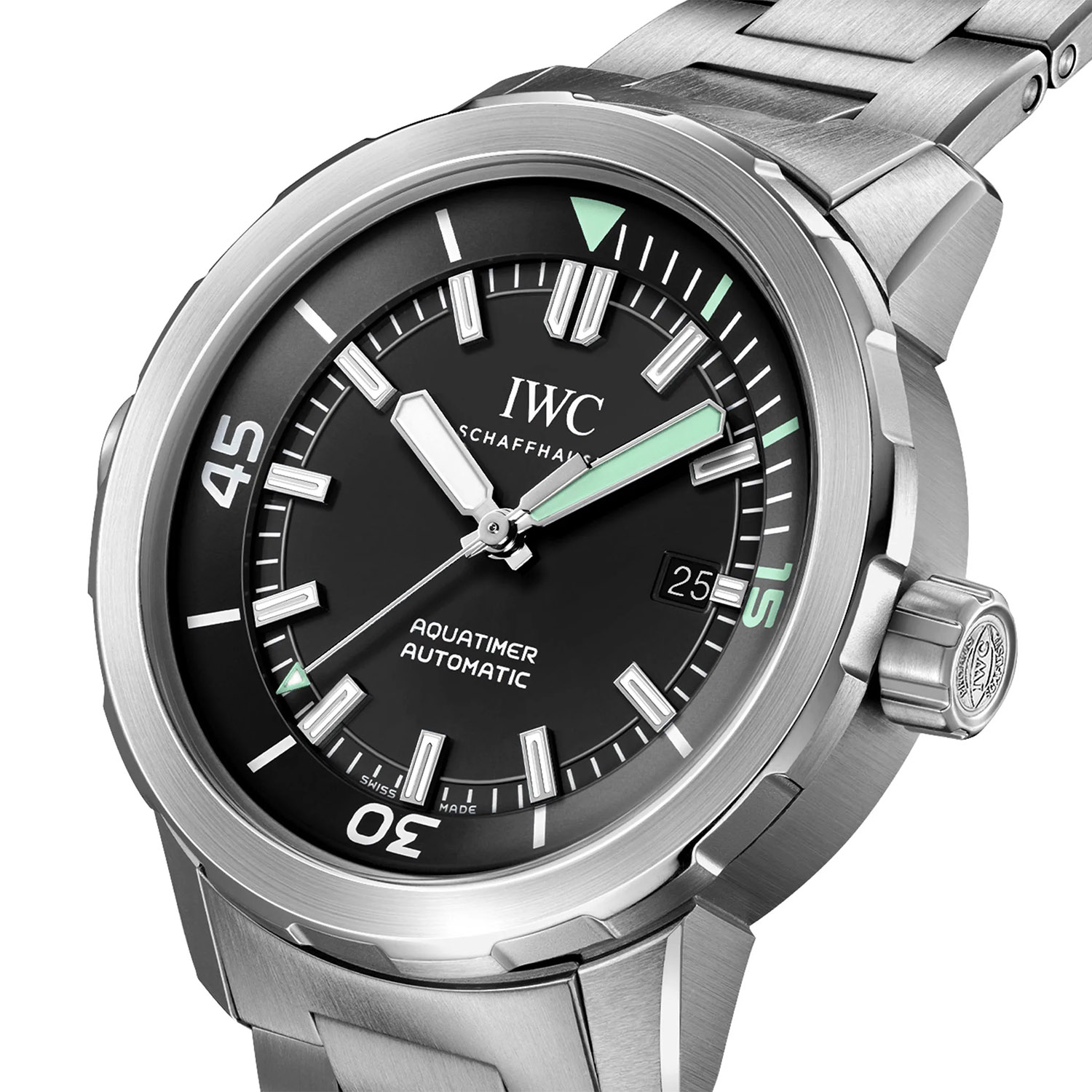

From a design standpoint, the 2022 collection introduces very few changes. The dial choices expand beyond the previous permanent black option to include a new blue sunray-brushed variant, adding a touch of modern flair while maintaining legibility with large hands and indices generously coated in white Super-LumiNova. Each model comes with a quick-change system for easy swapping between rubber straps—blue for the new dial or black—and a brushed steel bracelet option, enhancing versatility for both sporty and casual wear.
The most substantial upgrade lies inside the case, where the longtime ETA-based calibre 30120 (derived from the 2892-A2 or Sellita SW300-1) has been replaced by the in-house developed calibre 32111. Produced by ValFleurier, a Richemont group facility, this movement shares its architecture with high-profile siblings from Panerai and Baume & Mercier but offers distinct advantages tailored to the Aquatimer’s needs. It retains the 28,800 vibrations/hour frequency but more than doubles the power reserve to an impressive 120 hours (5 days), enabling longer autonomy. Despite being hidden beneath the solid caseback, the movement is decorated with Geneva stripes and perlage, reflecting IWC’s commitment to refined finishing even on utilitarian timepieces.
Concluding Remarks
Since 1967, IWC’s dive watches have evolved from Super-Compressor pioneers to titanium and Ceratanium innovations, mechanical depth gauges, extreme-depth automatics, and complications. While less hyped than some rivals, the Aquatimer has earned cult status among collectors for its originality, engineering credibility, and blend of purpose-built design with refined watchmaking.
While some references and limited edition models did not make it to this story, what we have presented, we hope, presents an objective image of what IWC has achieved at various stages of its venture into underwater horology.
https://monochrome-watches.com/evergreen-complete-history-iwc-aquatimer-and-other-important-iwc-dive-watches/
